Energy Harvesting in Public Transport
Chapter One – Project Background and Significance
Introduction
Chapter 1 will present an introduction to this thesis’ topic, providing the background, purpose, and significance of the thesis topic. This chapter will also provide a context into the authors working profession, the company the author works for and how the thesis topic fits and aligns with the company’s business and direction.
Company Background
I am a Civil Engineer working for the Department of Transport and Main Roads (TMR) in Queensland. TMR is a Queensland Government Department responsible for safe, efficient and effective movement and connection of people, places, goods and services (TMR, 2018). This includes pedestrians, cyclists, light vehicles, freight, public transport, and marine (coastal). TMRs role is for the implementation and execution of works in alignment with the policies of the Queensland Government. My role in TMR is Engineer who manage Motorways. I provide engineering technical advice, guidance and direction to the planning, design, and implementation of the Motorways in Queensland, including all associated and effected Intelligent Transport System (ITS) infrastructure. My role is to look at effective and efficient design and management of Queensland’s motorways. At TMR there is now an increasing and greater focus on preparation of the network in the roll-out of autonomous vehicles all across Queensland. Every day there is growing research into new systems, technologies, and developments in the field of cooperative intelligent transport systems globally. This is the background to how and where my proposed thesis topic started. My experience has allowed me to witness the connections and alignments between the emergence of smart, cooperative and intelligent technologies in the transport sector and those aiming for more energy efficient and ‘greener’ technologies. Many projects and initiatives are currently getting invested in the field of renewable energy, greener energy, and smarter energy. This includes electric vehicles, hybrid vehicles, the Tesla’s, energy efficient and smarter vehicles. However, there is currently a gap in the understanding and appreciation of energy harvesting technologies in Australia. Recent policies released by the Queensland Government have fortified the Government’s objectives of climate change and sustainable development, in particular, the Zero Emissions Transport Roadmap (Queensland Government, 2017). There are three critical commitments in the climate strategy in the country including powering Queensland with 50% renewable energy by 2030, achieving zero net emissions by 2050 and reduction of carbon pollution by at least 30% lower than the 2005 levels by 2030 (Queensland Government, 2017). The technologies and benefits of energy harvesting would be very beneficial to Australia’s energy and transport sectors. As such, my thesis will aim to carry out a feasibility study in the field of large-scale energy harvesting technologies through Queensland’s public transportation systems. However, is important to note that acquiring required and enough data about energy harvesting in Australia from various relevant authorities for a comprehensive assessment of comparisons and costs of energy harvesting technologies in this thesis has been a continuing challenge. Therefore, this thesis has only focused in the sector of public transport particularly trains and buses. As I am currently working and residing in the state of Queensland, I would like the focus of my thesis research to be bound to this region. My aim for the future will be to make recommendations for furthering my research to broader areas of Australia.
Project Background
Our understanding and appreciation of energy production and utilization are developing every day. We are increasingly becoming more aware of the negative impacts, particularly the emancipation of greenhouse gases and its contribution towards global warming. Much emphasis is now on the utilization of environmentally friendly products and services, the practice of ‘greener’ lifestyles and the consumption of renewable energy (Smith, 2015). There are many research and development projects in the field of renewable energy that is currently happening and being worked on around the world. Australia is one of the states with its geographical location making it ideal for establishment, testing and implementation of such technologies. According to Smith (2015), Australia’s wind resource is among the best in the world. Its solar energy has the potential to power the country for 10,000 years, its wave energy from the oceans is enough to supply five times of its electricity needs. Additionally, hydrogen gas is plenty (generated by splitting water into hydrogen and oxygen). Approximately a third of the world's uranium (nuclear energy) is in Australia in addition to its sufficiently available geothermal and bioenergy. The Department of Environment and Energy stated that their transport sector is the largest consumer of energy in Australia (Energy.gov, 2018). On the other hand, the Australian transport sector is now becoming more energy efficient, and although emitting fewer greenhouse gases per kilometer, transport demand is increasing at a higher rate and hence resulting in increased greenhouse emissions to approximately one percent per year (Smith, 2015). For gasoline vehicles, CEC (2006) states that only 15 percent of fuel energy gets utilized in cars (Energy.ca.gov, 2018). The U.S. Department of Energy says that approximately 21 to 40 percent of fuel energy from hybrid vehicles is used to drive vehicles while about 72 to 94 percent of the energy is used to power electric vehicles (Energy.gov, 2018). Further, in the report, it is stated that the energy losses for gasoline and hybrid cars are due to their engines (engine friction, pumping of air and wasted heat) and driveline inefficiencies (Energy.gov, 2018). Although electric vehicles are more energy efficient, there are still losses due to charging of battery, braking and powering of accessories (Energy.gov, 2018). Melcher (2016) provides a solution to such losses and inefficiencies by implementation and utilization of energy harvesting technologies within vehicles’ mechanisms and instruments. Melcher (2016) states that energy harvesting has the potential for cleaner and more efficient operating vehicles, hence reducing greenhouse gas emissions and fuel consumption. Energy harvesting is the process of capturing and accumulation of by-product energy as it becomes available. This energy is stored and later used for a variety of applications. This idea and technology, the harvesting of freely available energy are not new with applications such as windmills and watermills from the ancient times (Mide Technology, 2018).
Today’s world has become more complex technologically. The examples of available energy harvesting tech include mechanical energy from vibration, stress and strains, thermal energy from heat of combustion engines, friction and furnaces, electromagnetic energy from inductors, coils, and transformers (S3.amazonaws.com, 2018). In the transport sector, there is currently many research and works occurring in the field of energy harvesting. For instance, CSIRO’s tasks on motion energy harvesting, including capturing of vibration energy from large civil structures such as bridges (S3.amazonaws.com, 2018). It is estimated that the Sydney Harbour Bridge could generate enough power for approximately 200 homes. Thermoelectric generators are another example of recent energy harvesting technology whereby waste heat from car exhaust is captured and transformed into electricity. This energy is then utilized for vehicles’ electrical system, resulting in reductions in engine-load, fuel consumptions and greenhouse gas emissions (Melcher, 2016).
Project Aim
The aim of this thesis is to investigate alternative energy harvesting methods and implement a feasible solution for large-scale energy harvesting through public transport in Queensland.
Project Scope
The scope of this thesis is finding a workable solution for energy harvesting through public transportation which passes by on-road.
Expected Outcomes
The expected outcomes of my thesis will be a better understanding and appreciation of energy harvesting technology in Queensland through its public transport systems. It will be an assessment of energy harvesting systems practicality in operation and implementation. Although this is not and will not be a new system, the outcomes of my thesis will aim at providing an understanding of the current works and researches in the field of energy harvesting and how it can or possibly can benefit the state of Queensland. My ultimate aim will be to suggest the implementation and utilization of this technology for the betterment of Australia. My thesis is a feasibility study and as such my solutions and outcomes will be providing justifications, reasoning and supporting evidence for the effectiveness and practicality of large-scale energy harvesting through public transportation systems in Queensland. I will be offering a detailed assessment of the technology requirements in both Australia and Queensland.
Thesis Structure
This thesis contains six chapters. The first chapter is about introduction of the thesis. The second chapter includes a literature review of the thesis topic which investigates existing technologies used in the world for energy harvesting. The third chapter includes a deep study on existing public transport systems in Queensland. The fourth chapter is about my proposed solution to utilize energy from public transportation in Queensland. The fifth chapter is about solution development and its implementation. The sixth chapter contains cost-benefit analysis and a conclusion of the thesis.
Concluding Remarks
This chapter presented an introduction into the thesis topic, providing the background, purpose, background of the writer and the significance of this thesis’ topic. The aim of this thesis is to investigate alternative energy harvesting methods and implement a feasible solution for generation of large-scale energy harvesting through public transport in Queensland. The expected outcomes of my thesis will be a better understanding and appreciation of energy harvesting technology in Queensland through its public transport systems. It will be an assessment of the energy harvesting systems practicality in operation and their implementation.

Chapter Two – Literature Review
Introduction
This chapter presents a brief review of existing knowledge and information on public transport and energy, alternative energy sources and energy harvesting. Past works and research carried out on energy harvesting and public transport is also examined. A vast study is carried out on the public transport system of Queensland. The economic benefits, environmental benefits and the fields of application of energy harvesting are also reviewed.
Source of Literature
Today, energy harvesting is one of the debated topics for renewable energy. I have looked into the usage of modern technologies for energy harvesting and read different methodologies that are being used locally and internationally. In this regards, research material has been studied which includes research papers, research journals, and articles. These research materials have been analysed and accomplished. The detail of each topic is discussed in this chapter
Review of Literature
Overview
In this chapter, a literature review has been done. The energy harvesting solutions around the world have been explored particularly in Australia. In this regards, different research papers and articles have been read. The research includes traditional methods for energy production, alternative energy solution for electricity production like solar energy, wind energy, and harvesting energy. The advantage and disadvantage of existing electricity production sources have also been discussed. An analysis has been done on energy losses in transportation. Transportation energy can be utilised for production of electricity. A deep study has been done on new renewable energy resources and feasibility to implement harvesting systems locally in Australia especially in Queensland.
Energy
The Oxford dictionary (2018) defines energy as ‘the property of matter and radiation which is manifested as a capacity to perform work such as causing motion or the interaction of molecules. From simple walking to the switching on of lights, the generation of electricity, the use of computers, air conditioners and running of cars, planes, trains, and buses, all require energy to operate and function (Gallagher et al., 2018)
Energy usage
As stated by Ritchie and Roser (2018) a key pillar to the wellbeing, poverty alleviation and economic development is our access to energy. The source, type, and application of energy have developed, evolved and advanced over time (Pant et al., 2010). Figure 2.2 and 2.3 (below) from Ritchie and Roser (2018) illustrates energy consumption by continental regions of the world between 1965 and 2015. It is exemplified in the figure that during this period global energy consumption skyrocketed by more than 350 percent, with Asia Pacific, North America, and Europe contributing the greatest. Figure 2.1 depicts about the world energy consumption and its growth with the passage of time. This figure provides information about energy consumption and its growth in different regions from Asia to Africa. It is apparent from then figures that the consumption is growing continuously.
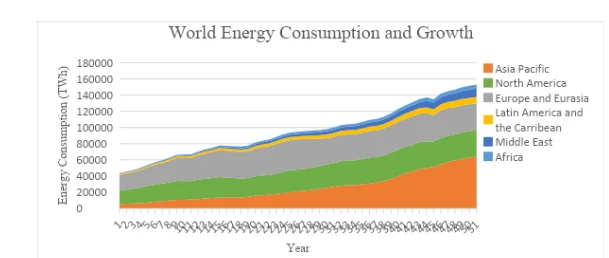

The era of energy consumption started with the use of coal (Ritchie and Roser, 2018). The modern fuels of today have replaced the human energy systems of the past like muscle, food for labor and animal feed. This understanding is critical in highlighting the importance of our reliance and understanding of the transition of energy consumption exemplified in Figures 2.1 to 2.11 below (Ritchie and Roser, 2018). These figures exemplify reliance on energy and their existence. During the 1800’s it is interesting to note the portion of energy exerted and generated from human muscle, animal muscle and fuel from wood. This was particularly true for Italy with approximately 91.5 percent energy exerted (Ritchie and Roser, 2018).
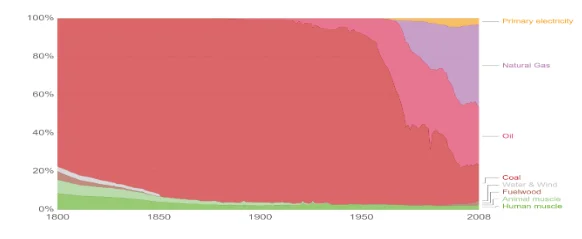


The above figures provide information about consumption of energy in Italy and Canada. This figure depicts consumption of energy in the 18th century. During this period energy was taken from human muscle and animal muscle. With the passage of time, consumption of energy shifted towards fuel-wood in the 19th century (Ritchie and Roser, 2018). In the middle of the 19th century, energy consumption shifted towards water and wind. At the end of this century it shifted towards coal and oil (Ritchie and Roser, 2018). The traditional methods for electricity production depend upon natural resources (Santos et al., 2014). However, natural resources decay continuously making them unreliable (Santos et al., 2014). Nowadays the consumption is shifted towards renewable energies like solar energy, wind energy, and the harvesting of energy (Destek and Aslan, 2017).
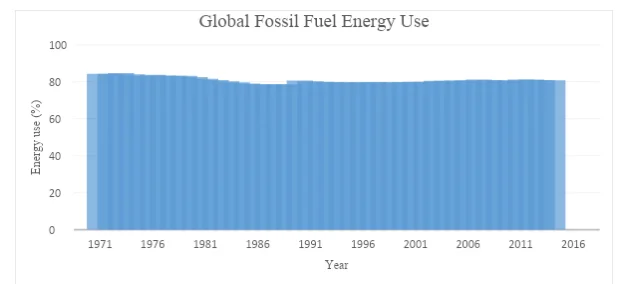
The above figure 2.15 depicts global fossil fuel energy use. Fossil fuel is the main energy source around the world (Wang et al., 2017). Every country depends upon fossil fuel. This figure tells us that about 80% of energy was acquired from fossil fuel between 1971 and 2013. The fossil fuels is a natural source. It is decreasing with the passage of time at a very low percentage. This data depicts that long-term reliability on fossil fuel is unreliable. It also affects the global environment (Peters et al., 2017).
Traditional Energy Sources
A majority of energy generated in Australia is from traditional energy sources. In fact, this is true for approximately 86 percent of electricity generated, which 73 percent is from coal and 13 percent is from natural gas (Lu, Blakers and Stocks, 2017). The importance of traditional methods for electricity production cannot be ignored but these methods are costly and unreliable. The traditional methods depend on natural resources. These natural resources decay with the passage of time and the demand for electricity is becoming high every day. So there will be a gap between demand and supply (Peters et al., 2017). The detail of resources for the production of electricity from traditional resources (including their advantages and disadvantages) are discussed in these next sections.
Petrol (Leaded/Unleaded)
Petrol is the biggest source of energy which is used for the production of electricity. Like other non-renewable energy sources, this fluid is the finished result of long periods of decay of natural materials (Wang et al., 2017). There are three technologies used to convert oil into electricity: The first one is Conventional steam where Petrol is burned to heat water to create steam to generate electricity (Jamal et al., 2017). The second technique is the use of Combustion turbines where Petrol is burned under pressure to produce hot exhaust gases which spin a turbine to generate electricity (Jamal et al., 2017). Additionally, there is Combined-cycle technology where Petrol is first combusted in a combustion turbine, using heated exhaust gases to generate electricity. After these exhaust gases are recovered, they heat water in a boiler, creating steam to drive a second turbine (Jamal et al., 2017). One of the main challenges for using petrol is that despite of it being a natural source, it is decaying from the soil (Gray and Taylor, 2018). Furthermore, the demand for energy is getting high with the passage of time. Hence the cost of petrol is increasing due to a shortage of petrol worldwide. Therefore, it is not a permanent sustainable solution for energy production (Gray and Taylor, 2018).
Diesel
Diesel generators are very useful machines that produce electricity by burning diesel fuel (Choichan et al., 2018). These machines use a combination of an electric generator and a diesel engine to generate electricity (Choichan et al., 2018). Diesel generators convert some of the chemical energy, contained by the diesel fuel, to mechanical energy through combustion. This mechanical energy then rotates a crank to produce electricity. Electric charges are induced in the wire by moving it through a magnetic field (Choichan et al., 2018). In an electric generator application, two polarised magnets usually produce the magnetic field. A wire is then wound around the crankshaft of the diesel generator many times, which is placed between the magnets and the magnetic field (Choichan et al., 2018). Diesel is a bi-product of crude oil. This method of producing electricity is very expensive and natural energy resources are decaying by the time. So it is not a reliable and permanent solution (EnergyInst.org, 2018). The challenge of using diesel is that torque is less in diesel, consequently the pulling force is less. The idling performance of diesel is weak. It expends a high amount of fuel while running on low rpms (revolutions per minute). Besides, the overall fuel efficiency is less so the amount of consumption is high and hence fuel cost of the vehicle becomes high. The diesel source is natural and natural resources are decaying with the passage of time, hence it is not a long-term reliable solution (EnergyInst.org, 2018).
Gas (LPG)
Liquefied petroleum gas (LPG) is an excellent choice of fuel for power plants where natural gas for various reasons is not available. There are a number of reasons for the increasing popularity of LPG for power generation. LPG is a cleaner fuel than heavy fuel oil as well as LPG is traded as a commodity worldwide making it readily available. Its transportation is easy by sea, rail or truck, regardless of batch size. Its storage of LPG is relatively simple and does not require cryogenic storage tanks. Lastly, the distribution infrastructure for LPG is readily available in many countries as it is used for transportation, industry and also small-scale heating and cooking (Gastgivers, 2017). This gas is also a less expensive method for electricity production as well as it is the most popular method to produce electricity. But it is a natural resource that decays with time. So it is not a long-term solution for energy production (Gastgivers, 2017). The main challenge of using LPG is that to liquefy Methane, the main component of Natural Gas, it needs to be chilled down below -164 Celsius which consumes a lot of energy (Gastgivers, 2017). Keeping it below that temperature constantly performs active cooling of the tanks. For a ship loading LPG from a port and taking it to the destination, the quantity of energy needed to first liquefy and then maintain LPG in a liquid state amounts to 10–25% of the energy generated when the LPG is liquefied. Due to the wastage of energy in compression, the cost of using LPG gas becomes high (Gastgivers, 2017). The production of electricity through mechanical technology is environmentally unfriendly. It is also protected and reliable. Energy output is also predictable and high (Behnam, Arefi, Shafii, 2018). However, wear on the parts may limit lifespan and piezoelectric materials used in some devices may become faulty over time. The machine size is another issue with electromagnetic devices. There is also limited practical operational duration with this technique (Behnam, Arefi, Shafii, 2018). Another technique is thermal or pyro-electric Energy which has a long lifespan and the potential for human body-worn applications. But it produces low energy. That is why it has higher cost, low power output (about 40µW/cm3); limited usage due to higher temperature gradient requirements and the power output depends on thermal gradient conversion efficiency (Namdeo and Pawar, 2017). Biochemical Energy production on the other hand provides availability of constant fuel source and implantable applications for human beings. But this technology is sensitive to the external environment and is not available commercially. There are also limitations on the lifetime and reliability of biological components (Ladd et al., 2018).
Alternative Energy Sources
Alternative energy sources are not acquired from fossils (Prodan, 2017). The traditional methods for electricity production are not cost effective. Its resources are decaying with the passage of time. If countries depend only traditional methods then it will create a problem in the production of electricity, demand will be high. Ultimately it affects the economy of countries unable to fill the gap between energy demands and supply (Santos et al., 2014). Alternative energy sources are used to address the issues of fossil fuel like emission of carbon dioxide and global warming (Prodan, 2017). Alternative Energy sources are cost effective and provide a long-term solution. Most countries are investing in an alternative source like solar energy, wind energy and harvesting energy (Prodan, 2017). The detail of the alternative source is discussed in the next section.
Solar:
Solar energy is radiant light and heat from the sun that is harnessed using a range of ever-evolving technologies such as solar heating, photovoltaics, solar thermal energy, solar architecture, molten salt power plants, and artificial photosynthesis (Green et al., 2017). It is an important source of renewable energy and its technologies are broadly characterised as either passive solar or active solar depending on how they capture and distribute solar energy or convert it into solar power (Green et al., 2017). Active solar techniques include the use of photovoltaic systems, concentrated solar power, and solar water heating to harness the energy. Passive solar techniques include orienting a building to the Sun, selecting materials with favorable thermal mass or light dispersing properties, and designing spaces that naturally circulate air (Green et al., 2017). The main challenges of using solar energy are that the solar energy is stored in battery that has a very limited lifetime. Hence the operation cost becomes high (Green et al., 2017). The power output of solar panels is expressed as watts, which is a measure of the amount of electricity that can be generated by the solar panel. Solar panels for domestic purposes typically produce between 225 to 360 Watts of electric output (Theecoexperts.co.uk, 2018). Sometimes, solar panels are not able to fully maximize electricity production as this depends on the outside temperature and number of hours it is exposed to sunlight (Theecoexperts.co.uk, 2018). Solar energy is also used in transportation. The first bus to use solar energy was introduced in 2013 in Australia, Adelaide by the Adelaide city council (Greenmatch.co.uk, 2018). This was with the intention to reduce carbon emission by the city. This buses totally rely on electricity to operate. The bus has a battery that is charged back in the city. The battery can last for over 200km then it is drained and requires a recharge. The battery life of these buses is also extended slightly by their regenerative brakes (Greenmatch.co.uk, 2018).
Wind
Wind power is the use of air flow through wind turbines to provide mechanical power to turn electric generators (Gebraad et al., 2017). Wind power, as an alternative to burning fossil fuels, is plentiful, renewable, widely distributed, clean, produces no greenhouse gas emissions during operation, consumes no water, and occupies small space on land. The net effects on the environment are far less problematic than those of non-renewable power sources (Gebraad et al., 2017). Wind farms consist of many individual wind turbines, which are connected to the electric power transmission network. Onshore wind is an inexpensive source of electric power, competitive with or in many places cheaper than coal or gas plants (Gebraad et al., 2017). Offshore wind is steadier and stronger than on-land and offshore farms have a less visual impact, but construction and maintenance costs are considerably higher (Gebraad et al., 2017). Small onshore wind farms can feed some energy into the grid or provide electric power to isolated off-grid location. The main challenge of using wind energy is that wind energy depends on the wind which is a natural source. The wind plant is implemented in those areas which have a high wind speed. But sometimes the wind does not blow to generate energy. Therefore it increases the operation cost of the plant. Hence the cost of generating energy becomes high (Gebraad et al., 2017).
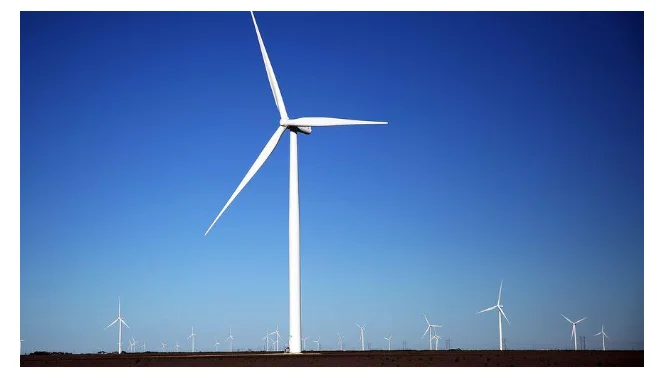
According to Sciencing (2018), the latest wind turbines have unique designs that aid in capturing wind efficiently. In an ideal environment, a wind turbine can convert 100% of passing wind into power. However, due to factors like friction, wind turbines have efficiency of 30% to 50% in terms of electricity output. The power output of wind turbines is calculated as follows:
Electric power= [(Air density)*(Swept area of blades)*(Wind speed)]/2
Area is in M2
Air density is in Kg/M3
Wind speed is in M/Sec
According to Sciencing (2018), just because a turbine has a certain megawatts rating does not mean it will generate the exact amount of power practically. They often generate considerably less power than their rated capacity. Nonetheless, Sciencing (2018) claim that industrial scale wind turbines have the potential ratings of two to three megawatts. This amount of power is however often reduced by wind availability and efficiency (Sciencing, 2018). There are evidences that trains can be powered by wind energy. According to the Phys.org (2018), all Dutch trains are being powered using wind energy. A single windmill running for one hour is able to power a train across approximately 200kilometres (Phys.org, 2018). Additionally, there are evidences that buses and trucks can be powered by wind energy. According to Tony (2018), wind turbines are driving the bus and truck fuel economy. Tony (2018) point out that wind turbines operate by disturbing air as they move through it. He further says that buses and truck also cut through air. Therefore, the scientific principle of wind turbines and buses or trucks of cutting through air are similar. Buses and trucks are fitted with wind turbines attached with EcoFin Vortex Generators to enhance aerodynamics around them and increase energy production (Tony, 2018).
Transport and Energy
Activities of transportation are responsible for huge energy consumptions when they offer mobility to freight and passengers. Transportation accounts for at least 25% of the total energy consumption worldwide (Wu, Yuan and Xin, 2017). Transport and energy sources can be used to boost the development of sustainable transportation systems because these sources are renewable and have a lower environmental impact than diesel and gasoline. The transport energy can be utilised to produce electricity and this electricity can be sent to the grid station (Wu, Yuan and Xin, 2017). The market of transportation gets affected by three factors, volatility and price levels of energy, energy performance levels through technical and technological changes, and environmental externalities. Research shows that transportation accounts for about 61.5% of the total oil consumed every year (Wu, Yuan and Xin, 2017). Its detail is discussed in the next section.
Transport in Australia
There are many forms of transport in Australia, including road, rail, sea and air. Australia is highly dependent on road transport. There are more than 300 airports with paved runways. Passenger rail transport includes widespread commuter networks in the major capital cities with more limited intercity and interstate networks (Black, 2018). The Australian mining sector is reliant upon rail to transport its product to Australia's ports for export (Black, 2018). There are 3 different categories of Australian roads. They are federal highways, state highways, and local roads. The road network Intra-city public transport comprises a total of 913,000 km broken down into Commuter rail, Trams, and light rail Rapid transit (Williams, 2017). Investment in Australia’s total road network has been relatively constant at around one percent of GDP since at least the late 1980s, with a significant increase from the early 2000s (Figure 3). This reflection both increased Commonwealth and private sector (PPP) funding. PPP stands for purchasing power parity and is a theory, an economic concept which elaborates how the exchange rate of currencies is in equilibrium with each other especially when the currencies’ purchasing power is equal or the same in every one of the two states (Williams, 2017). The National Highway system link connects all the state and territory capitals and terminates at the edge of each capital city. It was established under the act ‘to encourage and contribute, to a major extent, to trade and commerce, overseas and among States (Williams, 2017). Road transport is an essential element of the Australian transport network and an enabler of the Australian economy. There is a heavy reliance on road transport due to Australia's large area and low population density in considerable parts of the country (Black, 2018). Another reason for the reliance on roads is that the Australian rail network has not been sufficiently developed for a lot of freight and passenger requirements in most areas of Australia (Lennox and Dixon, 2018). This has meant that goods that would otherwise be transported by rail are moved across Australia via road trains. Almost every household owns at least one car and uses it most days (Black, 2018). Australia has the second highest level of car ownership in the world. It has three to four times more roads per capita than Europe and seven to nine times more than Asia (Black, 2018). Australia also has the third highest per capita rate of fuel consumption in the world (Parker et al., 2018). Melbourne is the most car-dependent city in Australia, according to a data survey in 2010 (Rissel et al., 2018). Melbourne has 110,000 more cars driven to and from the city each day than Sydney. Perth, Adelaide, and Brisbane are rated as being close behind. All these capital cities are rated among the highest in this category in the world (car dependency) (Rissel et al., 2018). The distance traveled by car (or similar vehicles) in Australia is among the highest in the world, exceeded by USA and Canada (Rissel et al., 2018).
Public Transport in Queensland
In Queensland public bus services are coordinated by the Queensland Government's Department of Transport and Main Roads (TMR) and provided by over 1000 operators (Yen et al., 2017). The coordination of public bus transport generally falls under three schemes: TransLink services, QConnect services and the remaining rural/regional school services. There are also private bus services in Queensland offered by some operators (Yen et al., 2017). The public trains in Queensland are managed by the Queensland rail. Queensland rail not only is a monopoly rail system but also has the obligations and responsibilities under law to offer transparent and open access to its systems for all operators under the Queensland Competition Authority (Queenslandrail.com.au, 2018). Brisbane is Queensland’s third most populated city as well as its capital. In Brisbane alone, people spend 68 minutes commuting through public transport on weekdays (Moovitapp.com, 2018).
Besides, 23% of Brisbane’s population use public transport every day for two hours including Ferry, Bus, Train and Light rail. These 23% of the population cover an average of 9.0 km (single journey e.g. from work) (Moovitapp.com, 2018).
Energy usage/losses in cars
No less than one-third of a car’s fuel consumption is spent in overcoming friction, and this friction loss has a direct impact on both fuel consumption and emissions (Liu et al., 2018). There are 612 million cars in the world today. The average car clocks up about 13,000 km per year, and consumes 340 liters of fuel just to overcome friction, costing the driver EUR 510 or 818.1 Australian Dollars per year (Liu et al., 2018). Of the energy output of fuel in a car engine, 33% is spent in the exhaust, 29% in cooling and 38% in mechanical energy, of which friction losses account for 33% and air resistance for 5%. By comparison, an electric car has only half the friction loss of that of a car with a conventional internal combustion engine (Liu et al., 2018). Annual friction loss in average car worldwide amounts to 11,860 MJ: of this, 35% is spent in overcoming rolling resistance in the wheels, 35% in the engine itself, 15% in the gearbox and 15% in braking (Mozafar et al., 2018). With current technology, only 21.5% of the energy output of the fuel is used to actually move the car; the rest is wasted (Litman, 2017). Reductions in frictional losses will lead to a threefold improvement in fuel economy as it will reduce both the exhaust and cooling losses also at the same ratio (Litman, 2017).

Energy usage/losses in buses
There is energy losses in buses due to friction. There are 200 million buses in the world today. Friction is an important energy consumer in transportation in buses representing some 15 to 20 % of the total usage of energy. The frictional usage/losses are 21 % of the total fuel energy and of this is 5 % consumed in the tire-road rolling contacts, 3 % in elastohydrodynamic contacts, 3 % in hydrodynamic contacts, 2 % in mixed and 2 % in boundary lubricated contacts. Viscous losses are 2 % and braking takes 4% (Masanes and Oppenheim, 2017).

Energy usage/losses in trains
The first law of thermodynamics says that energy cannot be created or destroyed; it can only change form (Masanes and Oppenheim, 2017). The South-eastern Pennsylvania Transportation Authority (SEPTA) are launching a project to build a battery storage network for its railway network that will capture and reuse energy released by the braking of its subway cars. SEPTA subway cars use a lot of energy, but then cast it off each time one of them stops at a station. When complete, the network will be one of the largest customer sited battery storage systems (the first commercially deployed for a transit operation) and serve as a model for using stored energy to supply power in congested parts of the grid (Warner et al., 2017).
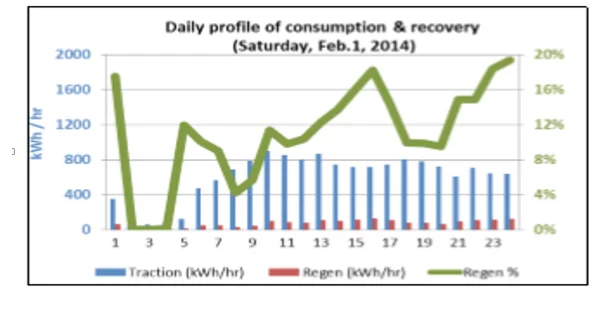
This diagram above shows energy recovery by event count and size. The profile shown for energy recovery is a function of the rate of stopping of the train. The table presents a profile as a fraction of the entire energy traction. The frequency of recovery decreases below 5% of the total traction energy at peak hours and above 20% at off-peak hours. The energy produced by these trains can be harvested to generate electricity (Septa.org, 2018). The possibility of scavenging electricity from railcar traffic was investigated by Nelson and colleagues (2008) by using piezoelectric devices and a technique of inductive voice-coil. Passing railcars over the piezoelectric devices (placed below the rails) caused a significant longitudinal strain. The longitudinal strain was then converted to electricity. An alternative method also investigated by these researchers was the use of an inductive voice-coil which was attached to a railroad. This device was driven by the rail’s vertical displacement. The average electricity harvested was about 1 mW for both the inductive voice-coil and the piezoelectric devices (Nelson et al., 2008). These techniques show great potential for the generation of electric energy and can also be used in Queensland rail network to produce energy.
Ferries:
A ferry is a merchant vessel used to convey travelers, and sometimes vehicles and freight operating on water. A public ship has numerous stops within the sea and many stations like public buses. Ferries are cost-effective public transport in numerous countries which has waterside urban areas and islands, permitting to travel to different coastal stations. The ferry travel needs very low capital route because if public buses get used in these routes, then the government needs to construct bridges over the sea. So the ferry is a very suitable public transport system used in Queensland. The ferry travel is also suitable for t he environment as compared to buses and rail because normal carbon dioxide outflows by ships per traveler kilometer appear to be 0.12 kg which is ideal for the environment and does not have the effects of global warming (Abs.gov.au., 2018).
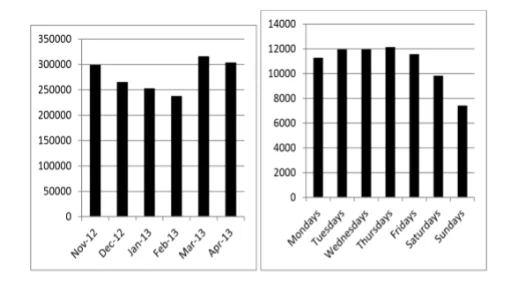
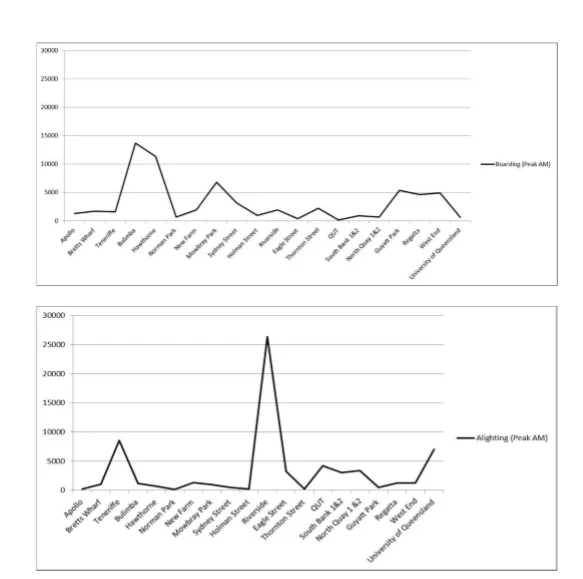
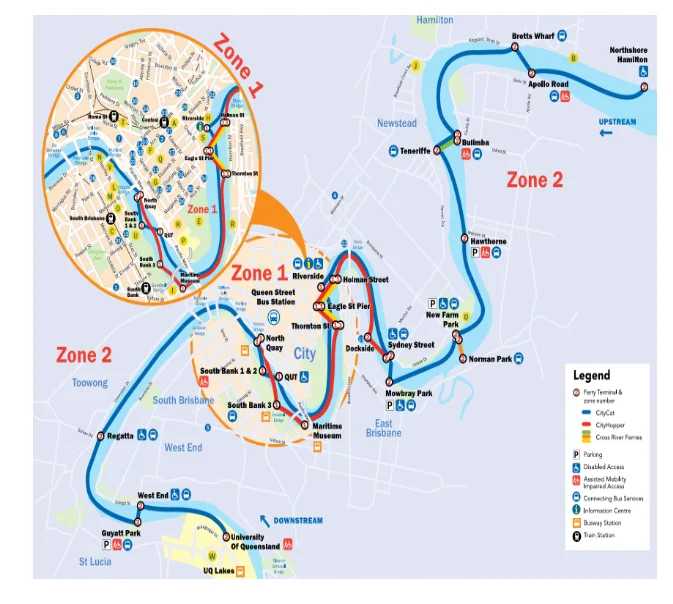
The usage of public transport (Train, Bus and Ferry)
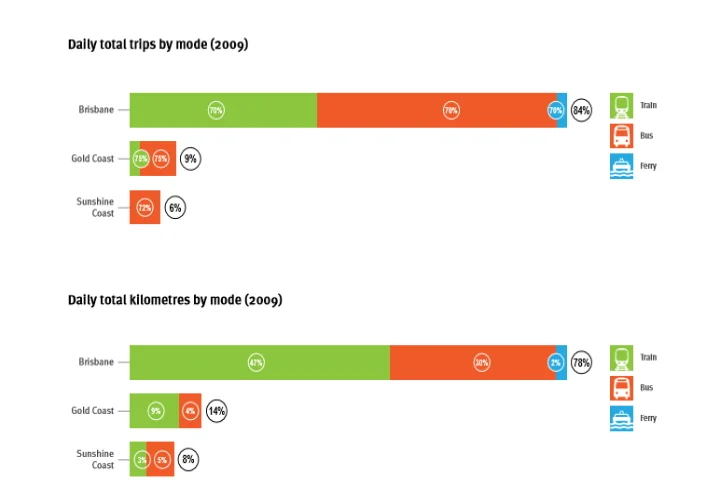
Brisbane residents make the majority of trips in South-East Queensland in regarding public transport. 84% of all trips in the public transport sector in terms of kilometres.
Harvesting
Energy harvesting is a process that takes small amounts of energy that would otherwise be lost such as heat, light, sound, vibration or movement (Xia and Shull, 2018). Energy harvesting also has the potential to replace batteries for small, low power electronic devices. One of the earliest applications of ambient power collected from ambient electromagnetic radiation (EMR) is the radio. This has several benefits such as no costs of maintenance free as there is no need to replace batteries. It is also environmentally friendly as disposal of batteries is tightly regulated because they contain chemicals and metals that are harmful to the environment and hazardous to human health. It also opens up new applications like deploying energy harvesting sensors to monitor remote or underwater locations (Xia and Shull, 2018). The history of energy harvesting dates back to the windmill and the waterwheel. People have searched for ways to store the energy from heat and vibrations for many decades. One driving force behind the search for new energy harvesting devices is the desire to power sensor networks and mobile devices without batteries. Energy harvesting is also motivated by a desire to address the issue of climate change and global warming (Xia and Shull, 2018). Energy harvesters provide a very small amount of power for low-energy electronics. While the input fuel to some large-scale generation costs resources (oil and coal), the energy source for energy harvesters is present as ambient background. For example, temperature gradients exist from the operation of a combustion engine (Xia and Shull, 2018). And in urban areas, there is a large amount of electromagnetic energy in the environment because of radio and television broadcasting (Matteo et al., 2017).
Small Scale Energy Harvesting
The production of nano-scale devices has drastically increased with the rise in technological applications, yet a major drawback to the functionality of nano-sized systems is the need for an equally small energy resource (Hsieh and Tsai, 2018). To address this need, the students of the University of Ahvaz in Iran have been modeling new piezoelectric energy harvester (PEH) technology at the nano-scale level. The team determined how small-scale dimensions impact nonlinear vibrations and PEH voltage harvesting (Zhu et al., 2018). According to Yeatman (2009), there are harvesting devices measuring as low as some cm to mm with energy output of micro-watts to milliwatts. Piezoelectric materials generate electricity from the application of mechanical stress and are utilised in everything from cell phones to ultrasonic transducers (Zhu et al., 2018). This electricity can also be generated by vibration-induced stresses, allowing scientists to create PEHs. These PEHs can be miniaturised down to a micro or nanosize and used in conjunction with nano-scale devices (Zhu et al., 2018). "Nowadays, the need for new miniaturised wireless sensors is growing. These MEMS [Micro-Electro Mechanical Systems] or NEMS [Nano-Electro Mechanical Systems] sensors usually require a power source of their size" (Sciencedaily, 2018). Piezoelectric energy harvesting is a well-known process for converting energy available in an environment into energy that can power small electric devices (Mide Technology, 2018). Traditionally, this has been used for generating a self-sufficient energy supply. Self-sufficiency is highly desirable for nano-scale devices due to the complicated nature of replacing small energy systems (Zhu et al., 2018). PEHs are gaining popularity for nano-scale applications due to their relatively simple structures, higher energy densities and ability to easily be scaled down (Zhu et al., 2018). Macro-scale models have been extensively studied and provided a strong base point to produce nano-scale models. Foruzande, Hajnayeb, and Yaghootian are taking advantage of these adaptable qualities and have generated nano-scale PEH models based on non-local elasticity theory (Zhu et al., 2018). "It's necessary to use this theory for other systems at nano-scale and also the sensors in nano-scale, which use piezoelectric materials (Sciencedaily, 2018)." Research teams have studied nonlinear vibrations and voltage based on nonlocal elasticity theory, which states that a point stress is dependent on the strain in a region around that point (Sciencedaily, 2018). Using this theory, they could derive nonlinear equations of motion with straightforward solutions. Their results showed that adding a nanobeam tip mass and increasing the scale factor would increase the generated voltage and vibration amplitude, hence increasing energy output (Sciencedaily, 2018). Modeling micro- and nano-scaled PEHs was also able to reveal just what impact size effects had on the output they could expect. The researchers found that the error of neglecting size is significant when comparing macro and micro PEHs. Neglecting various size effects resulted in lower estimations of PEH vibrations. Nano-scale sensor technology is becoming a hot commodity in the scientific industry due to its expansive applications. With applications in medicine, engineering, physics and more, nanotechnology has a lot to gain from the use of a stable energy source, such as these newly modeled PEHs (Sciencedaily, 2018).
Large Scale Energy Harvesting
Zuo and Tang (2013) point out that large-scale harvesting machines could produce one watt to 100 Kw or more Nowadays, harvesting energy from vibration is one of the most promising technologies. However, the majority of current researches show 10 µW to 100 mW power, which has limited applications in self-powered wireless sensors and low-power electronics (Musa et al., 2018). In fact, the vibrations in some situations can be very large, for example, the vibrations of tall buildings, long bridges, vehicle systems, railroads, ocean waves, and even human motion. With the global concern on energy and environmental issues, energy harvesting from large-scale vibrations is more attractive (Musa et al., 2018).
Other forms of large scaling
Tidal, Wave and Hydro Power
Energy from natural waves and tides can be harvested and utilized as clean and pollution-free electricity. Waves move along the ocean allowing the time of their arrival at the wave electricity facility more predictable as compared to wind. Tides are caused by the pull of gravity of the Sun or moon and can be predicted before they occur (Ltd, 2018). There are ambitious tidal power projects that are already producing 1.5 Mega-watts using their turbines (Eia, 2018). This has already happened in South Korea and in Scotland (Eia, 2018). In fact Scotland is planning to establish tidal turbines with the potential of producing 400 megawatts (Eia, 2018). Tidal energy, wave energy and hydro-electricity are mainly used for the generation of electricity. For instance, Tidal energy is used to produce 240 Megawatts of electricity at low costs in France. There are also smaller plants that produce sufficient commercial level Tidal electricity that are used in homes (Abhishek, 2011). Tidal energy particularly tidal barrages are used as energy reservoirs and to protect the coast during high storms (Abhishek, 2011). The first tidal lagoon construction began in 2016 along the Swansea’s Welsh city coast. The project is designed to be an enclosing of 11km2 and will generate 320 megawatts of electricity. This amount is sufficient to power over 155,000 homes thereby making it the world\s largest tidal power plant (Andrew Farris and Charlotte Helston, 2017).
Thermoelectric Energy Harvesting
Environments which naturally have heat flow and temperature gradients can produce electricity using a conversion mechanism known as thermal-to-electricity conversion of energy. A difference in temperature provides the ability for energy conversion that is efficient. However, even with sufficient heat flow, the expectable energy or power is usually low because of low material and Carnot efficiencies. Moreover, low heat presence also limits power production. Nonetheless, with exceptionally-low power systems like remote sensors that are wireless, thermoelectric power harvesting is seen as a viable method which is promising to be very prevalent because energy requirements for these devices decline (Ltd, 2018). According to Dahoon and Kyungwho (2018), a thermoelectric energy harvester stores electric power after harvesting generated waste heat by passing railroad vehicles. These individuals studied a thermoelectric module which was applied to change the temperature difference between the axle bearing housing surface and the air outside the housing into electricity. In their study, they conducted a lab-test on the output performance caused by the temperature difference and maximised the process through a computational fluid assessment of the fins that caused cooling. Their optimized thermoelectric power harvesting system was modelled and used on rolling stock. They then analysed electricity generation under operation. After about 57 min of the rolling stock including 300km/h maximum speed interval, 0.4 V, maximum open-circuit energy, was measured. Dahoon and Kyungwho (2018) claim that this energy can be used to self-power monitoring systems which are independent particularly low-power sensor nodes.
Triboelectric energy harvesting
Another technique is triboelectric energy harvesting which uses two principles operating collaboratively or in conjunction. The first principle is the electrostatic induction and triboelectric effect. Triboelectric effect or contact electrification occurs when two surfaces that are charging are brought in contact with each other (Ltd, 2018). This form of energy harvesting may be considered to be a type of electrostatic energy production because of how it works where an electric field is applied to collect produced generated energy. Triboelectric technique is based on the criteria of triboelectric effect. This effect comes due to contact electrification where some materials are electrically charged after they come in contact (also known as static electricity) (Panat, Wang and Parks, 2014). The contact electrification occurs from an electrical output from a polymer electret after the materials are in physical contact with each other. After the materials come together, they pass electrical charges to each other. Triboelectric energy harvesting techniques have improved significantly with time and are becoming applied in many areas. However, many researches on the technique focus on its optimization and development in terms of contact geometry, energy sources and power output (Wang, Chen and Lin, 2015). There has been advancements of smaller tribolectric energy harvesters known as triboelectric nanogenerators in the few past years (Wang, 2013). Triboelectric harvesters have also been used with different methods of harvesting energy to increase their benefits and decrease the weaknesses from each of the techniques. For instance the coupling of triboelectric and piezoelectric vibration harvesting (Han et al., 2015). There is also the coupling of triboelectric and electromagnetic harvesting for sensors that are self-powered (Fan et al., 2014). A group of a Chinese collaborator and a group of engineers from the University of Wisconsin-Madison have built a triboelectric-nanogenerator which is capable of harvesting energy from friction of a rolling car tire (Mao et al., 2015). The generator was able to change mechanical energy into electric energy using the triboelectric principle (the production of electric charge from rubbing together or contact of two different objects). Their nanogenerator relied on the triboelectric ability to produce energy from the electric potential which was changing between the vehicle’s wheels and the pavement (Mao et al., 2015). In this project, the electrons movement was able to produce sufficient electricity to power bulbs. Their results supported the idea that energy which is lost through friction can be harvested and reused (Mao et al., 2015). Such projects show that this technique is very promising in terms of energy harvesting and can be used in Queensland roads to harness energy.
Piezoelectric energy harvesting
Piezoelectric devices are usually appropriate for harvesting small-scale energy (1-10cm3) (Boisseau, Despesse and Seddik, 2012). Piezoelectric energy harvesting is very common in addition to being well researched in the field of mechanical power or energy harvesting. These appliances operate using a property of material called piezoelectricity. This material generates voltage or charges under mechanical stress stimulation. Various materials exhibit piezoelectricity like lead zirconate titanate, quartz, zinc oxide, polyvinylidene fluoride, and aluminum nitride (Hybrid Energy Harvesting Systems Using Electromagnetic and Piezoelectric Materials, 2015). The most commonly used materials in the piezoelectric technology are polymeric PVDF and ceramic PZT (Anton, Farinholt, and Erturk, 2014). The most recent development in this harvesting technology is the use of piezoelectric foam which is most preferred because of its relative strength as compared to the traditional ones (Kar-Gupta and Venkatesh, 2006). Most peizoelectric forms are made from Polythylene Terephthalate and Polypropylene (Anton, Farinholt, and Erturk, 2014). These devices have high voltage output. Piezoelectric devices can be placed in pavements to harvest energy. Research conducted by Xiaochen et al (2017) have shown that these devices can be installed in urban highways and roads. When vehicles run on these roads in high speed, the frequency of vibration in these piezoelectric boxes increases hence increasing the amount of energy generated. Although piezoelectric devices efficiency in energy collection is not sufficient for large-scale energy requirements, it is more appropriate for traffic facilities like traffic indicator brand and reminding on vehicles which are in the wrong or opposite direction (Xiaochen et al., 2017). The advantage of this technique is that it does not need long-distance power thereby allowing the possibility of traffic equipment’s to power themselves (Xiaochen et al., 2017).
Electromagnetic Energy Harvesters
The other form of energy harvesting is using electromagnetic energy harvesters. These harvesters operate on Faraday’s principle of induction. Many transformers, electrical motors, generators, and inductors use this fundamental working principle. The electromotive force or voltage produced in a circuit which is closed is directly proportional to the whole or total flux through this closed circuit (Hybrid Energy Harvesting Systems Using Electromagnetic and Piezoelectric Materials, 2015). The resultant energy of an electromagnetic energy harvester is 0.5 volts to 2.0 volts. Energy harvesting using electromagnetic harvesters can acquire energy from radio waves and vibrations. The coil and magnet can undergo interactive motion due to physical motion or vibrations. These activities can occur in seconds and may produce large amounts of energy (Beeby, Tudor and White, 2006). Currently electromagnetic energy harvesters are being applied in powering portable devices and wireless sensors (Beeby, Tudor and White, 2006).
Electrostatic electricity harvesters
Electrostatic energy harvsters generate 2V to 10V. The last type of energy harvester is using electrostatic electricity harvesters which operate on the variable plate capacitor principle. The mechanical energy which is present in the environment changes the space between two adjacent parallel plates. Together, these plates form a capacitor. The change in this gap results in charge flow exterior of a load linked across two platters. Electrostatic power harvesters which use a physical mechanism is differentiated basing on relative motion between two plates (Li, Misra and Gregori, 2017). Static electric energy can be used to control pollution by applying charge to dust molecules in the air. These dirt particles are then collected on a plate having opposite charge as the dirt (Ron, 2014). Electrostatic energy is also being used to paint cars. Many automobile producers first prepare the car surfaces. They then give the paint to be used an electric charge before spraying it (fine mist) into the painting booth. The paint particles which are charged are attracted to the car’s body. Once it dries, the paint sticks properly giving the car a smoother, finer look as the paint is distributed evenly on the car body (Ron, 2014).

Energy Harvesting in Australia:
The first step has been taken with a Mandatory Renewable Energy Targets, providing a powerful signal that the government is committed to supporting renewable technology (Ma et al., 2017). The challenging 20% renewable by 2020 target provides an opportunity for the supporters of such technology to demonstrate the capability of their industry (Ma et al., 2017). The issues associated with future energy options in a carbon-constrained world have been dominant themes for the Australian Institute of Energy in 2009. The eight branches and members across Australia are providing an informed debate on future energy supply, emission reduction programs, and complementary measures (Ma et al., 2017). Teams from Australia’s own CSIRO are developing technologies in vibration energy harvesting – from clothing to large structures, such as bridges and roads. Dr. Sam Behrens presents the latest from CSIRO’s Division of Energy Technology. One such project that has evolved into a start-up research company is the Windbelt, now under development by Humdinger (ABC NEWS, 2018). Humdinger claims that the Windbelt mechanism of generating energy requires no bearings thus making it efficient as compared to other processes of energy generation like wind turbines that are scaled down but experience tremendous friction. Windbelt energy generation is also preferred mostly for small-scale devices like in LED lights which are powered and used in rural communities (S3.amazonaws.com, 2018). Additionally, because of its aeroelastic flutter nature, Windbelt is adjustable or tuned to maximize or optimize its output at varying wind speeds (S3.amazonaws.com, 2018). The Humdinger firm also claim that Windbelt is quite cheap to manufacture or produce notably the smaller versions. They also have a longer lifespan of at least 20 years. Humdinger firm say that these devices can be readily built in countries which are still developing. The current application of Windbelt technology faces one challenge which is technology relativeness. Different Windbelt sizes are not yet becoming widely produced. Hence each Windeblt must become designed and developed individually (S3.amazonaws.com, 2018). Windbelt is less complicated as compared to the construction of conventional turbines. Additionally, developing wind turbines requires other mechanical units and gears to aid in rotating this turbine so that electricity gets generated. Very light winds to cause vibrations on its membrane and generate electricity. In fact, there is a prototype of Wind belt about ten to thirty times effective as than to micro turbines. Also, since the building of Wind belt is not expensive, it becomes a better alternative particularly in places where kerosene is applied for smaller power amounts. Humdinger says that while kerosene produces unhealthy smoke which is a health risk to humans causing health problems, Wind belts can be used to alleviate such challenges (S3.amazonaws.com, 2018).
Energy Harvesting around the World:
Energy harvesting is a process that takes small amounts of energy that would otherwise be lost such as heat, light, sound, vibration or movement (Du et al., 2017). Energy harvesting also has the potential to replace batteries for small, low power electronic devices. Now it is the era of renewable energy and it provides the best solution to produce electricity. Countries are shifting its energy sources towards harvesting energy. Traditional methods for energy generation are not reliable for the long term because fossil fuel is decreasing with the passage of time. If countries depend on fossil fuel then the gap between demand and supply of energy cannot be filled (Peters et al., 2017). Fossil Fuels are also affecting the global environment (Peters et al., 2017). The followings are researches which have been implemented in different countries.
Israel Model to generate electricity Using Piezo-electronics Devices
Israeli engineers have tested a 100 meter stretch of roadway installed with a system of Piezo Electric Generators (Schwartz, 2018). The piezoelectric effect converts mechanical strain into electrical current or voltage and the system is required to scale up to 400 kilowatts from a 1-kilometer stretch of double carriageway. The spearheading creation in the field of Parasitic is on the basis of energy collection which produces energy from weight, movement, vibrations and temperature changes and has other parasitic energy gathering applications in numerous fields (Schwartz, 2018). At first, however, the system can be arranged to produce and store energy from road, airplane terminal runways and rail system. The harvested energy from different resources can be exchanged back to the grid, or utilised for particular infrastructure purposes, such as lighting. The use of the system would enable greater scrutiny and thus comprehension of the conduct of road vehicles. Israeli engineers have also tested a stretch of what may turn into the road for future. The road contains piezoelectric crystal that creates power when pressed, empowering them to gather a portion of the energy which vehicles lose to the environment during their journey. The system is expected to deliver up to 400 kilowatts from a 1-kilometer stretch of the double carriageway. The technology is also applicable to airplane terminal runways and rail system (Schwartz, 2018). In addition, to produce its own power, the system can deliver real-time data on the weight, frequency, and speed of passing vehicles and the spacing between vehicles (Schwartz, 2018). Accordingly, the embedding of piezoelectric generators to make "smart road” could, in the long run, turn into a necessary part of traffic management system (Sharma et al., 2018). The Piezo Electric Generator created by Israeli University is increasing development for Parasitic Energy gathering (Sharma et al., 2018). The harvesting system of parasitic mechanical energy from roadways depends on the piezoelectric effect that converts mechanical strain into electrical current or voltage. The harvesting energy can be transferred back to the grid or utilised for specific road infrastructure. The infrastructure store energy for reuse (Shwartz, 2018). The generators are mounted with electronic cards providing the storage system. The laying of the present system, (installing the generators and electronic cards into the roadway), should be possible during paving of new roads or maintenance of existing roadways, so it's completely retrofit-table to any road. This implies that parasitic energy of busy roads, railways and runways can be converted into electrical energy that can be used for public electricity, or sustained back into the grid (Shwartz, 2018).
California model for Harvesting Energy
The California Energy Commission intends to find out how piezoelectric devices could turn road traffic into the dream of renewable energy. Energy harvesting methods have been growing in popularity lately in America. California has funded experiments on lot of traffic whereby roads which encounter substantial movement are fitted with piezoelectric transducers to convert the vibration produced by vehicles into electricity (Large.stanforededu, 2018). This electricity then is added into the grid to give energy to everything including buildings, homes, and road lights. Piezoelectric energy harvesting is not a new innovation. It's really been around for a time. In facts, energy harvesting has not exclusively been demonstrated. However, it is being used in a few sites (Large.stanforededu, 2018). For instance, a few prepare stations in Tokyo utilise piezoelectric energy to produce the power expected to run the ticket machines and electronic showcases (Du et al., 2017). Another model is a Dutch dance club which utilises piezoelectric tiles on the floor to control lights. Piezoelectric devices are more commonly used for generating sounds and measuring vibrations as opposed to generating electricity for energy consumption (Du et al., 2017). This makes finding energy data from piezoelectric energy harvesting rather difficult. However, there are currently transducers available that are specifically designed for generating electricity in energy harvesters. There are issues of costs of such a system. Piezo generators work in nightclubs and train stations since people are generally unlikely to destroy their pathways (Du et al., 2017). Since piezo devices rely upon deflection to deliver control, the trail needs to consider advancement and vibration to extend profitably of the collecting devices.
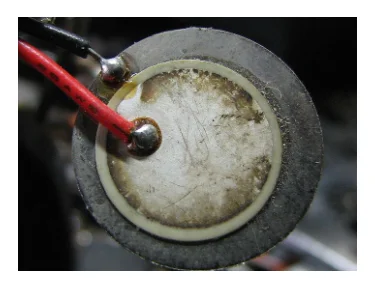
Roads must be built to restrict damage from tires and junk if they are to be secured and reliable (Du et al., 2017). As needs are, roads have a tendency to not move around and distort under impact. This makes putting transducers under roads dangerous on two fronts. Either the road is built to allow vibration imperativeness to accomplish the transducers which possibly makes the road weaker or the transducers don't achieve near their potential making them a costly investment (Schwartz, 2018). Furthermore, the world is moving from internal combustion engines to electric batteries. Combustion engines tend to vibrate even when they are stationary. Nevertheless, electric automobiles don't vibrate so much when stationary, thusly rendering the imperativeness gatherers less effective. This raises the issue of whether this piezo road will age with the expanding number of customers swinging to electric cars. In reality, California has apparently been the overall pioneer in the electric vehicle improvement beside China who competes aggressively for the electric car market.
Wireless System for Harvesting Energy
Wireless systems are becoming universal. It includes incorporated a wireless network based upon wireless availability of versatile gadgets and PC peripherals which utilise the Bluetooth standard. The utilisation of remote gadgets offers a few favorable circumstances over existing, wired systems (Chen et al., 2017). Its beneficial factor includes flexibility. However, the simplicity of wires is frequently a source of failure in such a system resulting in an extensive cost issue (Chen et al., 2017). At present, numerous wireless sensor hubs are battery controlled and work on economical budget. Efficient energy spending plan is required since consistent battery swap is not a possibility for systems with a huge number of physically inserted hubs. Besides, continuous battery replacement is not an option for networks with thousands of physically embedded nodes (Chen et al., 2017). Intelligence can also be used at the sensor hub to perform signal processing on the raw sensor data, execute interchange conventions and deal with the hub's power utilisation. These low-power wireless sensor hubs give a real incentive for elective sorts of intensity sources to conventional batteries. There are also solutions like smaller scale energy components and miniaturised scale turbine generators. Both the solutions include the utilisation of chemical energy and require fuelling when their supplies are depleted (Chen et al., 2017). Such systems are able to produce or generate large amounts of energy. They show great potential for the energising of, or notwithstanding supplanting, cell phone or workstation batteries (Chen et al., 2017). Renewable power can be acquired by creating electrical energy from light, warm and motor energy present inside the sensor. These sources can be utilised as either an immediate substitution or to expand the battery, in this manner increasing the lifetime and ability of the system and relieve the natural effect caused by issues encompassing the transfer of batteries. In this specific circumstance, solar based power is presumably the most well-known. Solar based cells offer phenomenal power density in coordinate sunlight. However, it is dependent on the surrounding light conditions and are plainly inadmissible in implanted applications where no light might be available, or where the cells can be obscured by contamination (Destek and Aslan, 2017). Thermal energy can be transduced into electrical energy using the Setback effect. Kinetic energy generators also convert energy through mechanical development present in the environment producing electrical energy. Kinetic energy is commonly present as vibrations, random displacements or forces and is regularly changed over into electrical energy utilising electromagnetic, piezoelectric or electrostatic components. Vibrations can be found in various applications including basic family merchandise (coolers, clothes washers and microwaves), mechanical plant gear, moving structures, such as vehicles and planes and structures, for example, structures and scaffolds (Destek and Aslan, 2017). The amount of generation by this methodology depends upon the amount and type of the kinetic energy available in the application environment, the efficiency of the generator and power conversion of the electronics (Destek and Aslan, 2017). The following section will discuss the essential soft kinetic energy harvesting and different mechanisms applied. This mechanism will then be illustrated by a comprehensive survey of generators created to date. There is a problem in using the field of vibration energy harvesting. With the predicted proliferation of wireless sensor networks, sufficient surrounding vibrations can help create an electrical supply by utilising a small scale generator to reap the mechanical excitation. There are three fundamental approaches that can be used to implement harvesting energy using wireless system (Chen et al., 2017).
Piezoelectric generators:
Piezoelectric generators offer the simplest methodology, whereby structure vibrations are directly converted into a voltage yield by utilising an electrode piezoelectric material (Shwartz, 2018). There is no necessity for having complex geometries and various extra segments. Piezoelectric generators are the most simple type of generator to manufacture and can be utilised in force and impact coupled harvesting applications (Shwartz, 2018). There is an extensive variety of piezoelectric materials available for various applications. Its advantages is that this transduction principle is particularly well suited to microengineering since several methods exist for saving piezoelectric films. The piezoelectric technique is equipped for creating generally high yield voltages however just at low electrical streams. Its transmission will be done with the wireless system. The piezoelectric materials require stress. Moreover, their mechanical properties allow large execution and a long lifetime (Shwartz, 2018).
Electromagnetic generators:
Electromagnetic generator offers a well-established technique of electrical power generation and the effect has been utilised for a long time in an assortment of electrical generators (Musa et al., 2018). Harvesting energy from roads and transmission is also done by the wireless system. High-performance bulk magnets, full-scale loops are promptly available. With Wafer-scales system, poor properties of planar magnets result in limitations on the number of turns achievable in addition to a limited amplitude of vibration (Musa et al., 2018).
Electrostatic generators
The electrostatic concepts are reliable and its working relies on the basis of the capacitor and storing of energy (de Queiroz, 2018). The energy source is the vibration taken from the road as well as its vehicle. The energy density of the generator can be increased by decreasing the capacitor spacing and encouraging scaling down. The energy density, in any case, is additionally diminished by decreasing the capacitor surface zone. High transduction damping, at low frequencies, is achievable by fusing small capacitor gap and high voltages (Musa et al., 2018). Shockingly, electrostatic generators require polarising voltage or charge. This is not an issue in applications that utilise the generator to charge a battery, as this can be utilised to give the vital introductory excitation level. Electrostatic generators can use electrets to give the underlying charge and these are fit for putting away charge for a long time. The transmission is done by the wireless system. The yield impedance of the gadgets is frequently very high and this makes them less suitable as a power supply. Capability requirements for custom circuit execution create difficult circuit designs. Parasitic capacitances within the structure can sometimes lead to reduced generator efficiency and there is a risk of capacitor anodes shorting or of 'stiction' in wafer-scale (Musa et al., 2018). The three primary techniques of harvesting energy from surrounding vibrations have become equipped for producing electricity. A few years ago, such energy levels would have been considered as 'unusable' (Musa et al., 2018). Advanced VLSI circuit plans work in light for low activity areas as well as many business areas. Circuits are now able to be applied or utilised in energy harvesting arrangements. The electronic calculator whose early frame required a few 'AA' measured cells, are currently capable of running completely off solar energy. Vibration-fueled remote sensor systems can also be utilised in various situations. Several research groups across the world are addressing possible applications of ambient intelligence, medical implants, and smart clothing (Chen et al., 2017). Wireless battery-less industrial condition monitoring system is about to commercialise in the market (Chen et al., 2017).
Discussion
Energy is the property of matter and radiation which is manifest as a capacity to perform work such as causing motion or the interaction of molecules (Gallagher et al., 2018). Our ability in performing a task or carrying out of particular works, manual or through external applications is essentially the result of energy. From simple walking to the switching on of lights, generation of electricity, the use of computers, air conditioners and the running of cars, planes, trains, and buses, all require energy to operate and function (Gallagher et al., 2018). As stated by Ritchie and Roser (2018) a key pillar to the wellbeing, poverty alleviation and economic development is our access to energy. The source, type, and application of energy have developed, evolved and advanced over time. Energy can be used for the production of electricity (Lu, Blakers and Stocks, 2017). There were many ways of energy production, from traditional to renewable and the costs associated are ever increasing. The production and utilisation of electricity is pivotal and very important throughout the world. With the associated and ever increasing costs in energy production and operation, there is also the question of energy efficiency and wastage. Where approximately 20% to 40% of fuel is actually utilised in the generation of the force in the movement of the vehicle a lot is wasted in friction, vibration, exhaust, heating and cooling. These wasted energy can be captured and utilised through energy harvesting. Harvesting energy is an innovative energy solution currently. Countries are shifting their energy sources into harvesting energy. The cost and natural reserve can also be saved (Xia and Shull, 2018). The focus of this thesis will be to explore the existing systems for harvesting energy (from around the world and Australia) and analysing how these technologies can be utilised to resolve energy wastage and inefficiency problems and challenges. The aim will be to identify applicable harvesting energy technologies that could potentially be utilised in Australia (mainly in Queensland) through public transportation systems. As detailed in this literature review there are currently research and works being carried out around the world in energy harvesting and there are technologies currently being tested and implemented accordingly.
Project Methodology
My thesis project is the carrying out and performance of a feasibility study in the field of energy harvesting technologies in public transport. My thesis project comprises of seven chapters. Chapter 1 is project background and significance, chapter 2 is literature review and project methodology, chapter 3 is current systems, chapter 4 is alternative solutions, chapter 5 is development and implementation of solutions, chapter 6 is cost benefit analysis and chapter 7 is conclusion and recommendation of future works. My project methodology will focus around the three main sections of literature review, main body and conclusion. In my literature review I have aimed at exploring and defining energy, energy harvesting, public transport in Australia and Queensland and the technologies currently and potentially available in the energy harvesting. This has provided a background to my thesis topic as well as potentially highlight the gap between energy harvesting technology and public transport. In my thesis main body I will identify the existing situation, all the existing large-scale energy harvesting technologies and their corresponding applications considering the context of applications. This will provide a better understanding of the entire appropriate energy harvesting technologies with regard to public transport systems. Moreover, I will identify those technologies suitable to Queensland’s situation, by comparing the working environment and conditions of each existing case. I will also be carrying out a cost-benefit analysis of the situations and scenarios in order to gain a better understanding and appreciation of the feasibility. I will also consider the technologies implementation easiness, the technology’s maturity, environmental protection, minimal interruption to the traffic during the implementation stage, and the operational and maintenance costs. Under the conclusion and recommended future works, I will do research and propose a portfolio of technologies for future investigations and. I will summaries my achievements throughout the project and highlight limitations or constraints so that I am able to propose future works in order to address those limitations or constraints, to come to an even better proposal for further development towards the realisation of adopting a novel large-scale energy harvesting system through public transportation in Queensland.
Chapter Three –Existing Public Transport System in Queensland
Queensland:
Queensland is the second-biggest and third-most populated state in the Australia. Queensland has a populace of 5,000,000 focused along the drift and especially in the state's South East (Fig 3.0). The capital and biggest city in the state is Brisbane, Australia's third-biggest city. Queensland is home to 10 of Australia's 30 most significant urban areas and is the country's third-biggest economy. Tourism in the state, fuelled to a great extent owing to its warm tropical atmosphere making it a unique industry (Abs.gov.au, 2018). There is more than 3.7 Million vehicles registered. There are three types of public transports that are used by people of Queensland which contains buses, trains, and ferries.
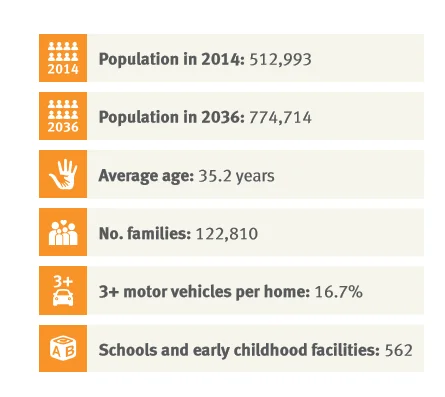
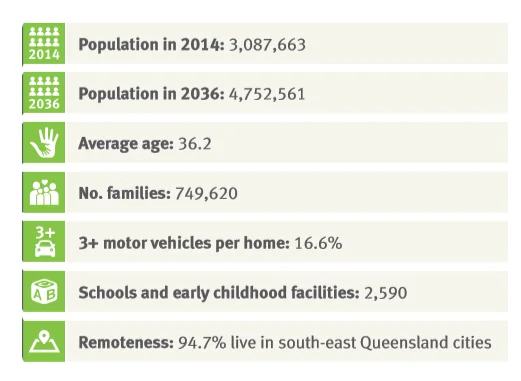
Public Transport in Queensland:
Queensland has an integrated public transport system operated by TransLink, which manage public buses, train, light-rail and ferry services through contracted administrators. The TransLink network operates a fare system which enables a single ticket to become charged at the same price irrespective of the number of transfers made on the trip. Regional transport and long-distance rail services are provided throughout the state by Translink. TransLink co-ordinates public transport in Queensland. Rail services (trains and trams) are operated by Queensland Rail, through its City arrange framework. Bus services are run by both the City Council's and private administrators and use the road network and designated bus lanes. Ferries only operate in the waters of Brisbanes. Transdev Brisbane Ferries operate the ferry services on the Brisbane River. Road transport along residential street network are managed by the City Council (Our World in Data, 2018). According to data issued by Gold-Coast-Australia-Travel-Tips.com. (2018) the average time of public transport utilization in a day is 68 minutes (Richards, 2010). Nearly a quarter of public transport users, ride for over 2 hours. The average distance people usually travel in a single trip is approximately 9 km, while 20 percent travel for over 12 km in a single direction (Richards, 2010).
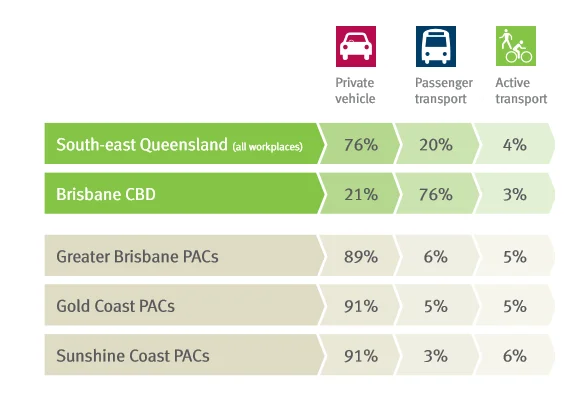
Buses:
Buses usually operate on 5 am to midnight including 24 hour services on Friday and Saturday nights. Most buses in Queensland are express (CityXpress). BUZ (Bus Upgrade Zones) or regular express routes provide services on main centers at least every 15 minutes on any day of the week from 6am to 11pm .In the peak hours, 'rocket' buses bypass the intermediate stops, for effective and efficient travel (Abs.gov.au., 2018).
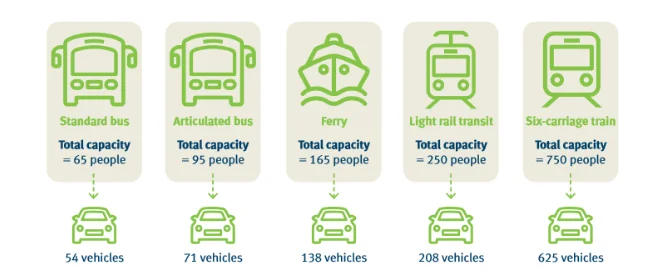
South-East Queensland household spends at least 195 Australian Dollars on a weekly basis on travel (Queensland Government, 2017). It is estimated that congestion will cost Brisbane 3 billion Australian dollars by 2020 (Queensland Government, 2017).
Queensland Rail:
The Queensland Rail City comprises of seven lines covering most parts south-west, north and outer east sides of the city. It also serves a portion of the route to the Airport line benefiting the public who travel between the City and Brisbane Airport. The Cross River Rail venture is a proposed 10.2 Kilometre rail interface ++making five new internal city stations and expanding the flow centre limit of the rail networks (Abs.gov.au, 2018).
3.2.3 Ferry Usage in Queensland in 2013
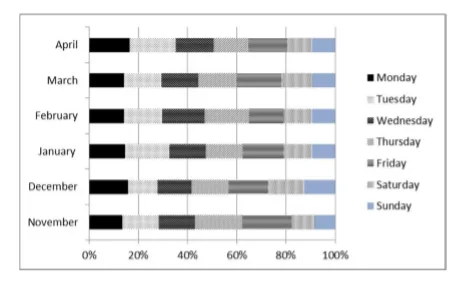
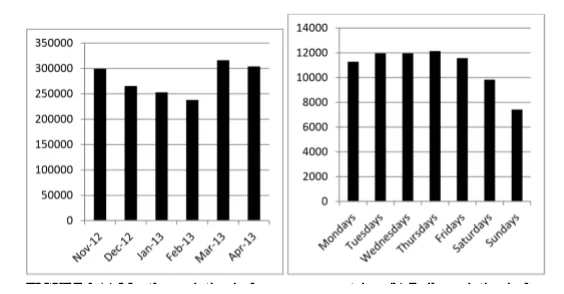
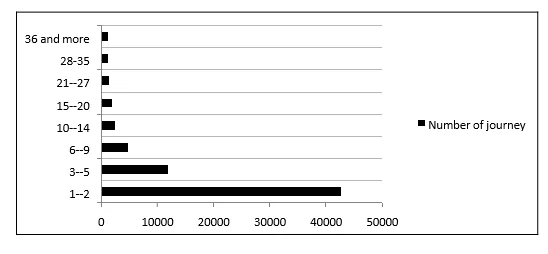
The figures above is a representation of how ferries make a significant number of trips as they move a huge proportion of Queensland population who combine other modes of public transport and ferry trips (Soltani et al., 2015).
Diesel Fuel in Public Transport:
The majority of buses and rails run on diesel fuel in Queensland. Some old transports still being used keep running on gasoline. Some traffic runs on propane or compressed natural gas, and there are a few that run on the electric system. These last are typically known as road autos regardless of whether they run on elastic tires or steel wheels along rails (Powerscorecard.org, 2018).
Why diesel Engine is used by public transports
The diesel motor is an internal burning motor in which the ignition chamber of the engine has starts by the hoisting temperature of the air in the barrel by mechanical pressure. Diesel engines work by compressing air. This compression builds air temperature inside the barrel to a high degree, to the point that atomized diesel fuel infused into the hot chamber lights immediately. This mechanism varies for different motors, for example, a petroleum motor or gas motor utilise a vaporous fuel rather than oil. They use a start attachment to touch off an air-fuel blend. In diesel motors, shine plugs might be used in a cooler climate, or when the engine uses a lower pressure proportion or both. The first diesel motor works on the "consistent weight" cycle of continuous burning. Ultimately it increases the performance of the engine (Powerscorecard.org, 2018). The diesel motor has an extremely efficient thermal energy of any possible internal or external combustion engine due to its very high expansion percentage and inherent lean burn which allows heat dissipation by the excess air. Diesel has a higher energy density, and requires smaller volume of fuel to perform a specific amount of work. Diesel motors infuse the fuel straightforwardly into the burning chamber. It has no intake air limitations separated from air channels and intake plumbing. It also has no intake complex vacuum to include parasitic load and pumping misfortunes coming about because of the cylinders becoming pulled or descending against admission framework vacuum. Furthermore, barrel loading with air occurs thereby allowing volumetric efficiency. Heavier fuels like diesel fuel have higher octane ratings and lower octane ratings, resulting in an increased tendency to ignite spontaneously and burn entirely in the cylinders when injected.
Disadvantages of Diesel
Increased compression ratios create higher combustion chamber temperatures to ignite the injected fuel. Increasing compression ratios in spark-ignition engines require higher octane fuels that are harder to ignite and burn completely and advanced spark timing to avoid pre-ignition, knocking and resulting performance losses or engine damage. Larger transport applications (trucks and buses) also benefit from the Diesel's reliability and high torque output. The disadvantage is that torque is less in diesel. Hence lowering the pulling force. The Idling performance of diesel is weak. It expends a high amount of fuel while running on low rpms. Moreover, the overall fuel efficiency is less so the amount of consumption is high, and hence fuel cost of the vehicle becomes high.
LNG Fuels in Public Transport
With the price of oil at high levels, and with increasing demand from consumers for measures to tackle global warming, some innovations for energy and the environment were put forward at the Inter-ferry conference in Stockholm. Alternative fuels are becoming more widespread on ferries. The fastest passenger ferry in the Queensland runs on LNG which reduce emissions considerably and displace costly diesel fuel. Liquefied natural gas (LNG) is natural gas (predominantly methane, CH4, with some mixture of ethane C2H6) that has been cooled down to liquid form for ease and safety of non-pressurized storage or transport (Wartsila.com, 2018). It takes up about 1/600th the volume of natural gas in the gaseous state (at standard conditions for temperature and pressure). LNG is odourless, colorless, non-toxic and non-corrosive. LNG achieves a higher reduction in volume than compressed natural gas (CNG) so that the (volumetric) energy density of LNG is 2.4 times greater than that of CNG (at 250 bar) or 60 percent that of diesel fuel. Therefore, LNG becomes cost efficient in marine transport over long distances. However, CNG carrier ships can be used economically up to medium distances in marine transportation (Wartsila.com, 2018). LNG can be used to fuel internal combustion engines. LNG is in the early stages of becoming a mainstream fuel for transportation needs. It is being evaluated and tested for over-the-road trucking, off-road, marine, and train applications. There are known problems with the fuel tanks and delivery of gas to the engine, but despite these concerns, the move to LNG as a transportation fuel has begun. LNG competes directly with compressed natural gas as a fuel for natural gas vehicles since the engine is identical. There may be applications where LNG trucks, buses, trains, and boats could be cost-effective to regularly distribute LNG energy together with general freight or passengers to smaller, isolated communities without a local gas source or access to pipelines. Transportation and supply is an essential aspect of the gas business since natural gas reserves usually are quite distant from consumer markets. Natural gas has far more volume than oil to transport, and pipelines transport most gas. There is a natural gas pipeline network in the former Soviet Union, Europe, and North America. Natural gas is less dense, even at high pressures than air. Natural gas will travel much faster than oil through a high-pressure pipeline but can transmit only about a fifth of the amount of energy per day due to the lower density. Natural gas is usually liquefied to LNG at the end of the pipeline, before shipping. Natural gas is a fuel and a combustible substance. Ensuring safe and reliable operation requires some measures in the design, construction, and maintenance of LNG facilities. In its liquid state, LNG is not explosive and cannot burn (Wartsila.com, 2018). For LNG to burn, it must first vaporize, then mix with air in proper proportions (the flammable range is 5 percent to 15 percent) and then be ignited. In the case of a leak, LNG vaporizes rapidly, turning into a gas (methane plus trace gases), and mixes with air. If this mixture is within the flammable range, there is a risk of ignition which would create fire and thermal radiation hazards. Besides the advantages of LNG, to liquefy Methane, the main component of Natural Gas, it needs chilling down below -164 Celsius which consumes a lot of energy, then to keep it below that temperature there is continually performed active cooling on the tanks. For a ship loading in from LNG port and then taking it to the destination, the quantity of energy needed first to liquefy and then maintain in a liquid state amounts to 10–25% of the power generated when the LNG is liquefied. There is also the risk that an LNG tanker will sink when loaded which would release all of that methane into the sea and atmosphere without burning it into CO2 and water vapor H2O. That would be a massive disaster because methane gas has the order of 100 times greenhouse warming potential of CO2 in the first twelve months after release. The transportation cost to take LNG container is also very high.
Existing challenges of using current energy harvesting technologies
Piezoelectric materials are widely used in energy harvesting to generate energy for low energy consuming equipment. Piezoelectric generating units have the advantage of compactness in design (Hanlon, 2018). Piezoelectric devices generate energy in the order of μW. Shi et al., (2016) explains that a piezoelectric vibrator can be placed under the road. According to the result of their study, a single energy harvester was able to generate 2.67mJ. Brandon (2011) did an investigation on piezoelectric film to check whether it can produce enough energy to translate signal through RF transmitter. He used 52μm film of polyvinylidene fluoride, and his prototype could create electricity within a range of 400-800μJ when a car ran over the film. This energy was around 4-8 times of the required energy to transmit four packets of 12 bit of data. Another type of modern road energy harvester is the electromagnetic energy harvester. This harvester generates electricity by absorbing external vibration into a moving part of the harvester. With a magnetic moving part, there is a fixed piece coil and vice versa. The benefit of using electromagnetic energy harvester is that size of the harvester is not crucial. Compared with piezoelectric energy harvesters which should ensure large contact area or a large number of units to generate a large amount of energy, an electromagnetic equipment can make one unit of energy by using a strong magnet and heavy weight of moving mass. When we consider the output power from one unit of the harvester, an electromagnetic harvester’s output is larger than a piezoelectric energy harvester. Also, electromagnetic equipment generates comparably high current output. Most of the electromagnetic energy harvesters have a larger size than piezoelectric harvester and generate comparably low voltage. But the drawback of this design is the pedal part which is on the road surface and slows down traffic. The highway regulation do not allow any protruding structures on the highway for purposes of safety. The potential disaster is that when a vehicle changes lane but the driver fail to notice the pedal structure on the road might cause a fatal accident.
Chapter Four – Consideration of Alternative Proposed Solutions
Green, efficient and effective utilization of energy is the current hot topic and one of the main challenges facing our world today. One such a solution may be the implementation of energy harvesters in our ever improving and increasing in use pubic transports. Energy harvesting is free from the effects of global warming which come from greenhouse gases. However, large-scale integration of energy sources creates environmental, economic, social and technical impacts that need to be investigated and mitigated as part of developing a sustainable power system for the future. Transportation plays a vital role in a countries economy and social development. In operating the transport system, there is a need for energy for vehicles and traffic monitoring system. However, cost-effective, convenient and reliable power supply is needed for the traffic monitoring system and is still a big challenge. The following sections will provide potential and preliminary energy harvesting technologies that may be beneficial and appropriate for the public transport of Queensland.. However, acquiring required and enough data about energy harvesting in Australia from various relevant authorities for a comprehensive assessment of comparisons and costs of energy harvesting technologies in this thesis has been a continuing challenge. Therefore, this thesis has only focused in the sector of public transport particularly trains and buses.
4.0 Energy Harvesting Solutions for buses
4.1 Generation of Harvested Energy with Piezometer and Other Existing Method
Many research centres are working on piezoelectric materials. These materials are applied to generate energy to power low energy consuming equipment. Piezoelectric generating modules have the advantage of compactness in design. However, the drawbacks of piezoelectric material are in their amount of harvesting energy that is in the order of μW. In piezoelectric devices, a single unit of energy harvester is able to generate 2.67mJ theoretically (Hanlon, 2018). Hanlon (2018) showed that 52μm film of polyvinylidene fluoride can create electricity with a range of 400-800μJ. Innowatech claims that their on-road energy harvester unit is able to generate 200kw/h for 1km lane of the road. However, its validity is questionable as there is not yet a practical product which has been used (Hanlon, 2018). A common technology used today is an inductive metallic loop detector which is placed under the road. However, there are gaps in this technology especially in monitoring and detection system. This is particularly true for traffic sensing and detection purposes as current traffic monitoring sensors, communication infrastructures and other transport systems associated with it depend on grid power and batteries. In remote and far areas of Queensland, grid power and transmission lines are sometimes technically or economically impossible to access. Wireless sensors may solve this problem with promising solution but still have challenges in battery energy supply. The vehicle detection sensors needs to be verified in high-volume traffic and extreme temperatures. Replacing and changing millions of batteries for tens of thousands of wireless sensors would be a substantial logistic challenge, and the maintenance cost could be huge especially in replacing batteries of sensor nodes embedded in the pavement. Another critical concern is the environmental impact of disposing off the used batteries (Hanlon, 2018). For solving the power transmission problems in traffic monitoring system and other transport systems associated with it, especially in the remote regions of Queensland, an innovative idea is proposed in this project which uses a quick motion mechanism to convert the motions from passing vehicles on highways to electrical energy. It is a green regenerative energy harvesting system. On the other hand, due to wide deployment of energy harvesters on the highway system, grid power is eliminated or is only deployed at limited places. As a result, the time and cost becomes significantly reduced for grid power installation and battery replacements within the highway system. The total energy consumption of the transportation system is also much reduced, which leads to a more sustainable transportation system (Energyeducation.ca, 2018).
Proposed Solution for Large Scale Energy Harvesting Technology for Buses
We have discussed innovative high and efficient energy harvester which is intended to be introduced under the road. We have seen that when a bus runs over the road surface, particularly above the top plate, the weight of the bus and its moving speed provides input to the top-plate. This input energy is used to rotate the main shaft of the harvester connected to the generator. As the bus’s front wheel runs on the plate, the top plate recovers to the initial position before the rare wheel arrives. This technology requires a one-way clutch or a joint between the top plate and main shaft, and a spring placed under the joint. To decrease the time and cost of installation, the harvester is designed in a compact manner with a detachable joint exposing the powertrain when the top plate is removed. The advantage of our proposed design over traditional energy harvesters is that it will not slow down the speed of traffic while it harvests energy from running vehicles. However, there are some challenges associated with our design. These challenges are related to the limited natural resources and environmental effects. Furthermore, there are other challenges expected to come from the speed of energy consumption and the very high demand. In this regard, researchers are working on renewable energy harvesting. Power supply and maintenance are important issues for traffic monitoring and detection systems in public transport, and is critical for safety in transportation. These challenges is because the transportation sector consumes almost one-third of the nation’s energy (Wilson, 2007). It is also due to the fact that the transportation system covers a large portion of the nation’s surface area where providing power (such as grid power) is extremely difficult, if not impossible particularly to remote areas.
4.2 Energy harvesting solutions for public trains
Mila (2015) wrote of students who developed five systems which are possible solutions for harvesting energy from public trains. Their first system was designed to produce electricity using an inductive coil put in contact with the rail. The coil is also placed above a magnet with radial magnetic-field. The coil shifted downwards and upwards in the magnetic field when the train passed over. In turn electricity was generated. The second systems included a piezoelectric material also attached to a rail. With the passing of the train, a strain was caused under the weight where the rail flexed adding mechanical strain on the piezoelectric strip producing power. These two systems produced electricity just sufficient to power small wireless sensors but could not power warning lights which was their target. They further conducted other trials using a ratcheting method also attached to a rail. The ratcheting mechanism was moved by vertical flexion turning its gearbox. The turning of the gearbox drove a generator which produced electricity. Their fourth trial was involved a hydraulic system where the vertical deflection caused by a passing train drove a motor and a hydraulic cylinder. The latter two systems generated sufficient power despite of relying on the rail’s flexion which is not always guaranteed especially during cold temperatures when the rails stiffen. Their last promising system involved the use of a spring-loaded-cam-mechanism also attached to a rail. When the train passed, each wheel pushed the mechanism pushing the spring back and the forth by the next wheel. An oscillating motion was caused which drove a generator thereby producing sufficient electricity that the team needed. The fifth system was able to light warning bulbs. Vasisht and colleagues (2017) conducted a feasibility study on how solar photovoltaic modules on top of rail coaches would perform. The focus of their experiment was to measure a decline in the consumption of diesel after electrical coaches would be established. These coaches were retrofitted with flexible (two) photovoltaic solar modules. These coaches were then run at high speeds of up to 120kn/h while coupling it to other three popular South India trains. The results of their experiments showed that a single solar coach can produce 18kWh of energy.
Chapter Five–Development of Solution and Its Implementation
5.1 Conceptual Design for Buses
Figure 5.1 below demonstrates the proposed energy harvesting technology for buses. This could also be utilized for normal passenger cars simultaneously. As per Figure 5.0, for buses and vehicles, tires roll over a collector introduced under road, the weight of the bus pushes the top plate of the harvester downward, which drives an electromagnetic generator to rotate and to produce electrical energy. A designed parameter of the vertical stroke of the equipment and the width of the top plate in the vehicle's lateral direction get determined according to the average tire deformation between the contact patch and the wheel hub. The tire deformation is caused by its interaction with the top plate in the same range as that when the tires roll over on the pavement. Thus, the response of vehicle passing through the harvester is similar to that rolling over on the ground, by which vehicle movement will not get influenced when passing through the equipment. Therefore, when tires move through the apparatus, a reasonable force reacting from the machine to tires will not change much than that reacting force from the ground, and as such the vehicles are not expected to slow down when approaching the apparatus.
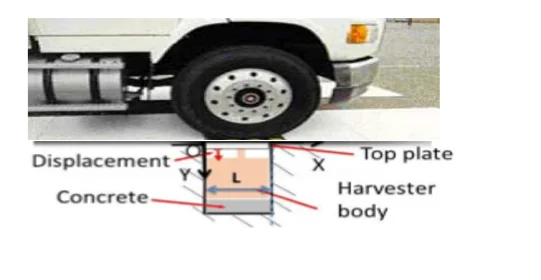
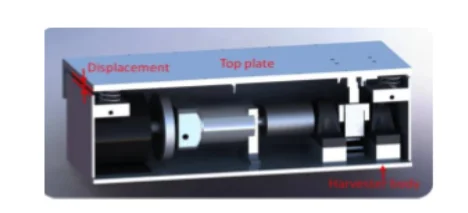
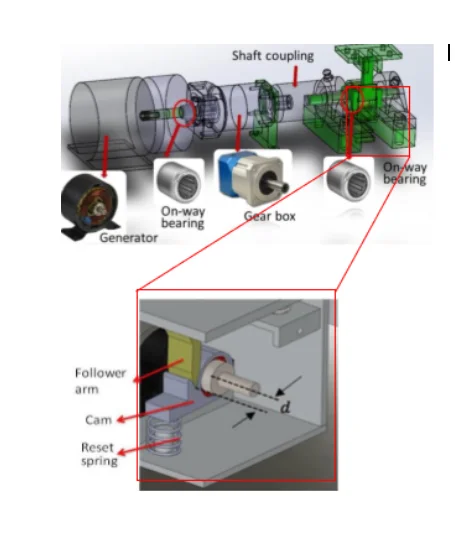
In the testing to maximise regenerative energy, a highly efficient energy conversion mechanism of mechanical motion rectifier (MMR) was designed as shown in Figure 5.11 and 5.12 which included a shaft, a pair of arm-cam, two pairs of one-way bearings, a gearbox, a generator and a flywheel. The one-way bearing embedded in the cam is similar to the one used in bicycle gears or engine starters to transmit motion in one direction. When the top plate moves downward, the one-way bearing is engaged, and the generator is driven to rotate to produce electricity. When the top plate moves upward under the rebound force from the supporting spring, the one-way bearing disengages from the generator shaft, and the generator then continues to rotate under inertia (moment) producing more electricity. Thus the generator can always turn in one direction, which can achieve high energy transmission efficiency and less backlash hence making the harvester more reliable (Wang et al., 2014). This MMR design in engagement and disengagement in one-direction is a half wave function of the MMR, which can transfer two direction vibrations into one direction as developed in other energy harvesters. This half-waveform MMR mechanism can solve the fundamental problem in large-scale impulse vibration energy harvesting which is short-time shock from vehicle to the equipment to achieve high energy harvesting efficiency. The gearbox is used to increase the rotation speed of the shaft to the generator and to increase the electrical transmission energy of the generator. There is another one-way bearing embedded between the flywheel and the shaft. Once the wheel spins at a higher speed than the shaft, the one-way bearing disengages the wheel from the pole, which can absorb the shock energy and protect the regenerator to be drastically driven by gearbox (Wang et al., 2014). The energy stored in the flywheel can then smoothly be released to the generator improving efficiency and reliability of the energy transmission. To regenerate more energy from the twice impulse-movements of the harvester caused by the front and rear wheel tires without influence to the vehicle speed, a unique flexible connection between the rear arm-cam structure become designed, as shown in Figure 5.3. The interaction between the sleeve and cam is in contact to avoid a fixed relationship and to disengage the top plate from the generator shaft much easily without any screwing connection. Moreover, disengagement of the one-way bearing in half-waveform MMR also enables the cam to be quickly disengaged with the rear arm and to recover the top plate to its original position (Wang et al., 2014). A rebound mechanism is installed at the top plate. This is a set of supporting springs at the top plate. The set of reset springs can enable the top plate to reset its original position in short time after vehicle tires pass through the harvester. Then the top plate of the equipment can be prepared for the next downward press to regenerate energy. It is essential for the plate to come back to its original position before the rear wheel axle comes in contact with it. If the top plate can be driven down again in its maximum displacement by the rear wheel, the twice press shocks from both front and rear tires can regenerate electricity energy twice to increase harvested energy (Wang et al., 2014). The design parameters of the stiffness of supporting springs and the displacement of the top plate are essential to meet the requirement of quick rebound, which need careful consideration according to the time between the two wheel axles passing through the harvests. The position limiters can constrain movement of the top plate in a certain range and also help to secure its continuous working to produce more electricity when many vehicles pass-by continuously. Furthermore, the shape design of the rear arm is essential to reduce contact area for improvement of the energy conversion efficiency, lessen the recovering time and increase the reliability of both arms and came. There is massive shock is transferred from tires to arm-cam connection, the strength of the arm and the friction between the contact surfaces of arm and cam are critical to the reliability of the structure. Figure 3 demonstrates optimized shape of the arm with a sharp end instead of round end based on finite element analysis of the arm-cam interaction. This proposed flexible contact interaction can simplify the structural parts, improve the energy harvesting efficiency, reduce the cost for production and release the maintenance load without influence to vehicle traffic on the road (Wang et al., 2014).
5.1.1 Prototyping
The fabricated prototype is as illustrated in Figure 5.4 (Wang et al., 2014). The size of the top plate is the length of 0.406m and width of 0.152m, the displacement of the top plate is 5mm. The gear ratio is 1:9 and the regenerator is 3 phase with the maximum output voltage of 24V and maximum output power of 100W

5.1.2 Simulation results
Based on the modelling of the on-road harvester (Wang et al., 2014), the dynamic characteristics of the equipment are numerically analysed when a vehicle passes through. The calculation was carried out by using Euler’s method of ordinary differential equation via Matlab as per the test. The parameters of the harvester and vehicle are listed in the following table. The simulation is carried out by assuming a car passing the harvester at a constant speed and only vertical vibration is considered to be used to drive the movement of harvester top plate.
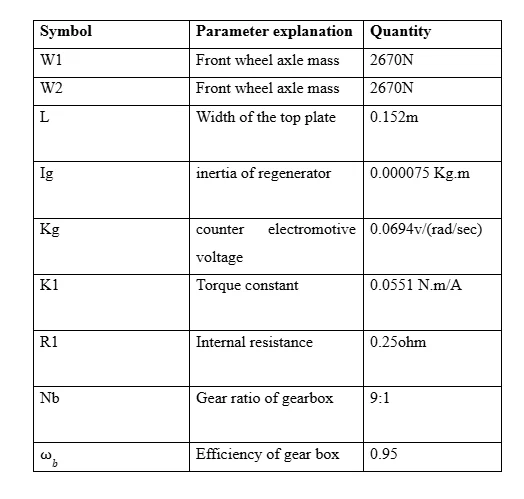
Figure 5.14 below illustrates the simulation outputs, the displacement, velocity and loaded force on the top. The two impulses indicate the front and rear wheel axles of the vehicle. Since the weight of the front axle is less than that of the rear wheel, the force of the first pulse is less than that of the second. The simulation results of output power demonstrate that more electricity can get produced after the load on the top plate is released. It conforms to the effectiveness of the half-waveform MMR to improve the energy harvesting efficiency. Therefore, to increase the output energy, the flywheel is stopped hence reducing the inertia force. A more lightweight generator (with less inertia) is adopted in a new design. Simulation results indicate output energy is doubled. There is very little displacement of the top plate (as shown in Figure 5.14) indicating a quick rebound to its original position under the spring sets.
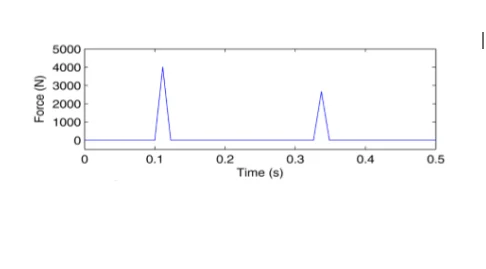
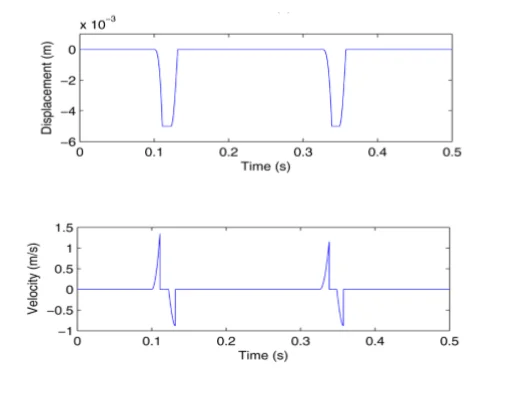
5.1.3 In-field test
In-field test were carried out by setting up a wood stands platform for a sedan car to drive over. The regenerative electrical voltage and power under various vehicle speeds with the external resistance of 10 Ohm connecting with the regenerative were measured, as shown in Figure 5.6. The highest power of 24 watts with output voltage about 5V was able to be produced at the vehicle speed of 5Mph (8.04672 Km/h). External resistance connecting with the regenerative power influences the amount of energy produced as shown in Figure 5.15 and 5.16, the larger the resistance is, the more energy produced.
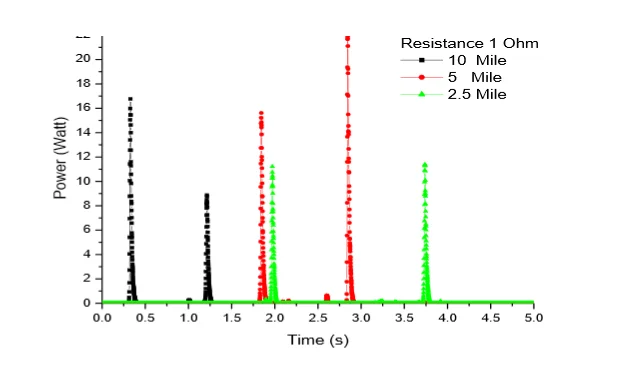

5.1.4 Conclusions
This harvester has shown capability to generate large-scale energy harvesting from road vibration caused by vehicles. High energy conversion capability is achieved by the used mechanical motion rectifier of MMR, which is able to maintain continuous rotation after the bus has rolled over the harvester. The dynamic model and simulation reveal the working mechanism of half-waveform MMR in the status of engagement and disengagement. Infield test was carried out by using a vehicle passing by the fabricated prototype. The measured regenerative electrical powers of 24 watts was harvested, which proved to be much larger than existing on-road harvester. The test results verify the effectiveness of the proposed design approach and modelling method. This large-scale impulse energy harvesting technology has good potential to be applied along bus routes as a self-power energy source.
5.2 Conceptual Design for public trains
Few states have commissioned as well as operated trains equipped with photovoltaic solar system on their rooftops. In India however, trains were fitted with 1kW solar power module in Punjab. The module was able to power 420 W load. The experiment was done for railway coaches with narrow gauge and which ran at 40km/h. Such experiments offer great opportunities regarding exploring renewable energy for public trains and reducing diesel consumption (Vasisht and colleagues, 2017). A coach fitted with photovoltaic solar system on their roof looks as shown in the figure below (Fig 5.17).
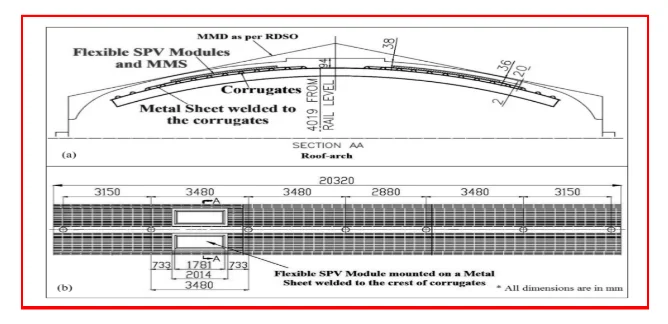
5.2.1 Prototyping
An important limitation that came up during this design was the appropriate standard dimensions. The standard measurements are declared by RDSO or the Research Design and Standards Organisation. According to the organisations guidelines, any additional body on a moving body like a trains should not be more than the maximum dimensions of the moving body. The solar systems were therefore fitted in accordance with the guidelines. Because the coach’s roof is curved, two mono-crystalline modules that are flexible (each rating 190W) were applied. To facilitate easy mounting and stiffness of the module, a flat surface was used on top of the coach’s roof. This was achieved by welding a 2mm thick steel (stainless) at the crest of the roof. A mounting structure was used to house the photovoltaic solar system. Rubber sheets were placed below the module to absorb any vibrations that would occur when the train moved (Vasisht and colleagues, 2017). To stick the module to the rubber sheets, silica gel was applied. To pack the spaces between the housing frame and the module, rubber gaskets were used. Copper strings were fasted across the housing frame to ensure the module’s safety. Cables were passed through hat-shaper conduits which were welded on the roof and allowed routing the electric cables into the train. The cables passed into the trains through their ventilation vents on the roof of each coach. The systems were further equipped with a pyranometer and an MMS to estimate solar radiation. A temperature sensor was also installed to measure module temperature. Further, an online monitoring system was built to analyse the module performance inside the coach (Vasisht and colleagues, 2017). The module is as shown in the figure below 5.18

5.2.3 Simulation results
The installed systems produced the following results: a maximum daily yield of 1.45kWh, a minimum daily yield of 1.31kWh and an average power output of 1.43kWh. Their results also produced a performance ratio of 79.5% on the daily trials which is a high value making their experiment feasible (Vasisht and colleagues, 2017).
5.2.4 Conclusion
This chapter has presented a conceptual design for harvesting energy on public trains using photovoltaic solar systems installed on the roof of train coaches. The design produce sufficient electricity based on the performance ratio calculated from the trial results which was 79.5% making the project a promising endeavour.

Chapter Six–Cost Benefit Analysis and Conclusion
6.1 Cost Benefit analysis of energy harvesting for buses
According to the Australian Bureau of statistic, there are 3,771,321 vehicles registered in Queensland and regular routes of public transport vehicles in each day adds to 66139 (Queenslandrail.com.au., 2018). As per the findings in chapter 5, each car is able produce 24 watts of electricity. So the standard cost to produce 1KW which include fuel cost, operation cost and maintenance cost is 1685 Australian dollar (Worthington and Higgs, 2017). In each day, the government can save 2.6 million Australian dollars by using the model. Therefore a saving of approximately 2.6 Million Australian dollars each day. Please refer to details below:
The average numbers of public transport in each day=66139
The numbers of watts of electricity can produced by using given solution=24watts
The total numbers of watts can produced by using given solution=66139*24=1587336 watts
Conversion from watt to kilowatt=1587336 /1000=1587.336kW
The average cost to produce 1MW=1685.403 Australian Dollars
The average cost to produce 1 Megawatt (Standard) =1904803.2Australian Dollars
The amount for watt produce in each day =1685.403*1587.336= 2675300.856 Australian Dollars
Hence the government can save energy of 2.67 Million Australian Dollars per day. The following table provides detail about amount and time that government can save by using harvesting energy though public transport.

According to above table, Government can save 2.6 Million Australian Dollars for one day, 18.2 Million Dollars for one week, 78 Million Australian Dollars for 1 Month, 468 Million Dollars for six months and 936 Million for one year.
6.1.2 Cost Benefit analysis of energy harvesting for public trains
The results from the photovoltaic solar system have been used to estimate optimal benefits from two panels of a typical solar train coach through considering the viability or feasibility of using roof-top space. Each coach is estimated to produce 18.5-20.2kWh leading to saving 4.6-5.1litres of diesel. The range of yearly yield of the solar coach is 6,820-7452kWh which saves 1,708-1,863 litres of diesel per coach. 4.5-4.9 tonne of carbon (IV) dioxide emission is reduced (Vasisht and colleagues, 2017).

Based on the outcomes of the train solar module, it is estimated that it will reduce 1,705 diesel consumption hence saving 1,237 USD (1,708.98AUD) per year. The module is also estimated to last for 15-20 years after which the systems efficiency reduces to about 85%. With a depreciation rate of 1%, it is estimated to have 10.6 years return on investment period (Vasisht and colleagues, 2017).
6.1.3 Conclusion
This chapter has presented the cost benefit analysis of using piezoelectric energy harvesters on buses and photovoltaic solar systems on trains. Using piezoelectric energy harvesters in each bus produces 24 watts of electricity. So the standard cost to product 1KW which include fuel cost, operation cost and maintenance cost is 1685 Australian dollar. In each day, the government can save 2.6 million Australian dollars by using the model. Therefore a saving of approximately 2.6 Million Australian dollars each day. On the other hand, the solar module on trains is estimated to reduce 1,705 diesel consumption hence saving 1,237 USD (1,708.98AUD) per year
Chapter 7-Conclusion and Recommended Future Works
7.1 Conclusion
The thesis has introduction into the thesis topic which has provided the background, purpose, background of the writer and the significance of this thesis’ topic. It has also introduced the aim of this thesis which is to investigate alternative energy harvesting methods and implement a feasible solution for generation of large-scale energy through public transport in Queensland. Chapter two has discussed a literature review of the energy harvesting solutions around the world and those explored in Australia. In this regards, different research papers and articles have been read including traditional methods for energy production, alternative energy solution for electricity production like solar energy, wind energy, and harvesting energy. The advantage and disadvantage of existing electricity production sources have also been discussed. An analysis has been done on energy losses in transportation. Transportation energy can be utilised for production of electricity. A deep study has been done on new renewable energy resources and feasibility to implement harvesting systems locally in Australia especially in Queensland. Chapter three has discussed the public transport system in Queensland including buses, trains, ferries and cars. It has also analysed use of diesel, LNG fuels and the existing challenges of using current energy harvesting technologies. Chapter five has looked into alternative proposed energy harvesting solutions in buses and trains using devices like piezoelectric technologies, and photovoltaic solar power systems. Chapter five has analysed the conceptual design for harvesting energy in buses and trains, in piezoelectric devices and photovoltaic solar systems respectively. Chapter six has discussed the cost benefits for energy harvesting in both buses and trains. In this regard, it is apparent that using piezoelectric energy harvesters in each bus produces 24 watts of electricity. So the standard cost to product 1KW which include fuel cost, operation cost and maintenance cost is 1685 Australian dollar. In each day, the government can save 2.6 million Australian dollars by using the model. Therefore a saving of approximately 2.6 Million Australian dollars each day. On the other hand, the solar module on trains is estimated to reduce 1,705 diesel consumption hence saving 1,237 USD (1,708.98AUD) per year.
7.2 Recommended Future Works
There is need to ensure ample time for communication and contact of relevant and appropriate personnel and stakeholders. Also, there is need to gather and collect all required data from appropriate personnel-attain contact early. Queensland should further investigation of energy harvesting technologies for teams and ferries. Additionally, there should be an in-depth investigation into the other energy harvesting tech for buses and trains as detailed in the theses. There is also a need to carry out in-depth investigation into the usage of the losses/inefficiencies in the fuel usage of current buses and trains-further investigate ferries and trains. All stakeholders should collaborate and contact canters such as the CSIRO and other transport agencies for data, information and assistance. Moreover, the government should investigate the public transport of other Australian states with the aim of capturing and identifying energy harvesting technologies for all public transport in Australia and identifying the greater savings for all Australia. Lastly, I recommend that comparing Australian studies to the rest of the world and assessing their impact from environmental, energy and costs perspective is necessary.
References
Anton, S.R., Farinholt, K.M. and Erturk, A., 2014. Piezoelectret foam–based vibration energy harvesting. Journal of Intelligent Material Systems and Structures, 25(14), pp.1681-1692.
ABC News, 2018. Perth team creates 'energy-harvesting' clear glass, viewed 5 September 2018,
Ahn, D. and Choi, K., 2018. Performance Evaluation of Thermoelectric Energy Harvesting System
Agarwal, PK, Yen, BT, Gurjar, J, Tseng, WC, Gupta, V, Mulley, C, Chiou, YC and Burke, M, 2017. Assessing Interchange Effects in Public Transport: A Case Study of South East Queensland, Australia. Transportation research procedia, 25(1), pp.4023-4041
Al-Graitti, AJ, Khalid, GA, Berthelson, P, Mason-Jones, A, Prabhu, R and Jones, MD, 2017. Auto
Rickshaw Impacts with Pedestrians: A Computational Analysis of Post-Collision Kinematics and
Injury Mechanics. World Academy of Science, Engineering and Technology, International Journal
Boisseau, S., Despesse, G. and Seddik, B.A., 2012. Electrostatic conversion for vibration energy harvesting. arXiv preprint arXiv:1210.5191.
Black, J, 2018. Urban transport planning: Theory and practice. Routledge.
Beeby, S.P., Tudor, M.J. and White, N.M., 2006. Energy harvesting vibration sources for
Braudel, F, 1992, Civilisation and capitalism, 15th-18th Century, Vol. I: The structure of everyday
Chaichan, MT, Kazem, HA, Chaichan, MT and Kazem, HA, 2018. Adopted Iraqi Photovoltaic
Chen, J, Guo, H, Liu, G, Wang, X, Xi, Y, Javed, MS and Hu, C, 2017. A fully-packaged and
Destek, MA and Aslan, A, 2017. Renewable and non-renewable energy consumption and
Economic growth in emerging economies: Evidence from bootstrap panel causality. Renewable
Du, S, Jia, Y, Zhao, C, Chen, ST and Seshia, AA, 2017. Real-world evaluation of a self-startup
Gallagher, CV, Bruton, K, Leahy, K and O’Sullivan, DT, 2018. The suitability of machine
Gebraad, P, Thomas, JJ, Ning, A, Fleming, P and Dykes, K, 2017. Maximisation of the annual
Green, MA, Hishikawa, Y, Warta, W, Dunlop, ED, Levi, DH, Hohl-Ebinger, J and Ho-Baillie,
Han, M., Zhang, X., Liu, W., Sun, X., Peng, X. and Zhang, H., 2013. Low-frequency wide-band
Jana, S, Biswas, S and Biswas, PK, 2018. Methodological model of Lightning Energy Plant
Kenworthy, J., 2017. Automobile dependence in Bangkok: an international comparison with
Kar-Gupta, R. and Venkatesh, T.A., 2006. Electromechanical response of porous piezoelectric materials. Acta Materialia, 54(15), pp.4063-4078.
Lennox, J and Dixon, J., 2018. A spatial general equilibrium analysis of transport policies in Sydney, Australia.
Li, Y., Misra, M. and Gregori, S., 2017. Comparison of conventional and regenerative electrostatic
Ma, D, Lan, G, Xu, W, Hassan, M and Hu, W., 2017. Poster: Unobtrusive User Verification using
Crystals: Effects of Off-Stoichiometry and Eu2+ Concentration. Crystal Growth & Design, 16(12),
Fraction of Municipal Solid Waste) to Energy-Environmental Sustainability in Urban Areas at
Mozafar, MR, Moradi, MH and Amini, MH, 2017. A simultaneous approach for optimal allocation of renewable energy sources and electric vehicle charging stations in smart grids based on improved GA-PSO algorithm. Sustainable cities and society, 32, pp.627-637.
Musa, M, Guala, M, Hill, C and Sotiropoulos, F., 2018. Hydrokinetic energy harvesting in large natural rivers: a multifaceted experimental study. Bulletin of the American Physical Society.
Nelson, C.A., Platt, S.R., Albrecht, D., Kamarajugadda, V. and Fateh, M., 2008, April. Power harvesting for railroad track health monitoring using piezoelectric and inductive devices. In Active and Passive Smart Structures and Integrated Systems 2008 (Vol. 6928, p. 69280R). International Society for Optics and Photonics.
Pant, D, Van Bogaert, G, Diels, L and Vanbroekhoven, K., 2010. A review of the substrates used in microbial fuel cells (MFCs) for sustainable energy production. Bioresource technology, 101(6), pp.1533-1543.
Peters, GP, Andrew, RM, Canadell, JG, Fuss, S, Jackson, RB, Korsbakken, JI, Le Quéré, C and Nakicenovic, N., 2017. Key indicators to track current progress and future ambition of the Paris Agreement. Nature Climate Change, 7(2), p.118.
Rissel, C, Crane, M, Standen, C, Wen, LM, Ellison, R and Greaves, S., 2018. Public support for Bicycling and transport policies in inner Sydney, Australia: a cross‐sectional survey. Australian and New Zealand journal of public health, 42(3), pp.309-314.
Richards, J, 2010. Lyall Ford, Roads in the Wilderness: Development of the Main Road Network in Far North Queensland - the First 100 Years, Brisbane: Queensland Government Department of Transport and Main Roads, 2009, ISBN 9 7819 2071 9081, 405 pp., $40.00. Queensland Review, 17(01), pp.79-82.
Sharma, S, Sharma, NC, Upadhayay, A and Hore, D, 2018. An Innovative Strategy of Energy Generation using Piezoelectric Materials: A Review. ADBU Journal of Engineering Technology, 7.
Shi, Y, Li, R., Xue, Y and Li, H, 2016. High-frequency-link-based grid-tied PV system with Small DC-link capacitor and low-frequency ripple-free maximum power point tracking. IEEE Trans. Power Electron., 31(1), pp.328-339.
Soltani, A., Tanko, M., Burke, M.I. and Farid, R., 2015. Travel patterns of urban linear ferry passengers: Analysis of smart card fare data for Brisbane, Australia. In The 94th Annual Conference of the, Transportation Research Board (TRB) (pp. 11-15).
Worthington, A.C. and Higgs, H., 2017. The impact of generation mix on Australian wholesale electricity prices. Energy Sources, Part B: Economics, Planning, and Policy, 12(3), pp.223-230.
Xia, H and Shull, PB, 2018. June. Preliminary Testing of an Angled Sliding Shoe for Potential Human Energy Harvesting Applications. In 2018 2nd International Conference on Robotics and Automation Sciences (ICRAS) (pp. 1-4). IEEE.
Wang, Z.L., Chen, J. and Lin, L., 2015. Progress in triboelectric nanogenerators as a new energy technology and self-powered sensors. Energy & Environmental Science, 8(8), pp.2250-2282.
Wang, Z.L., 2013. Triboelectric nanogenerators as new energy technology for self-powered systems and as active mechanical and chemical sensors. ACS nano, 7(11), pp.9533-9557.
Yeatman, E.M., 2009, April. Energy harvesting: small scale energy production from ambient sources. In Active and Passive Smart Structures and Integrated Systems 2009 (Vol. 7288, p. 728802). International Society for Optics and Photonics.
Zhu, G, Lin, Z, Jing, Q, Bai, P, Pan, C, Yang, Y, Zhou, Y and Wang, Z., 2018. Toward Large-Scale Energy Harvesting by a Nanoparticle-Enhanced Triboelectric Nanogenerator.
Zuo, L. and Tang, X., 2013. Large-scale vibration energy harvesting. Journal of intelligent material systems and structures, 24(11), pp.1405-1430.
- 24/7 Customer Support
- 100% Customer Satisfaction
- No Privacy Violation
- Quick Services
- Subject Experts



